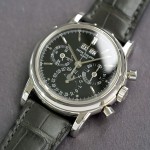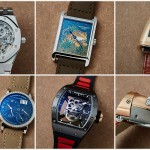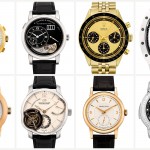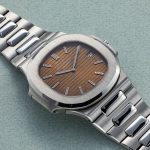Highlights: Complicated Wristwatches at Phillips Hong Kong
Past, present, and modern with vintage movements.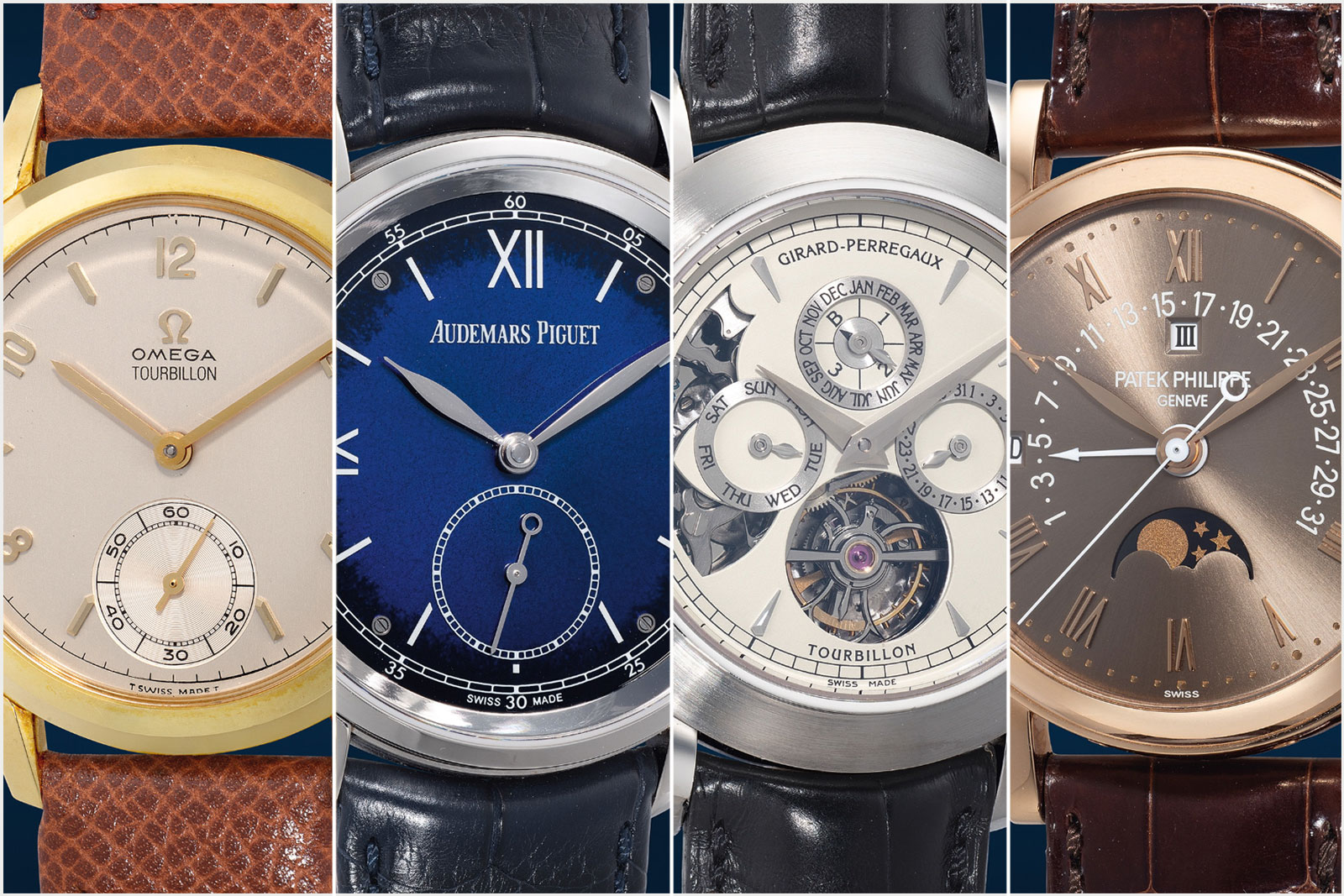
Having covered the highlights from independent watchmakers and historical pocket watches at The Hong Kong Watch Auction: XVIII on May 24 and 25, we now turn to complicated watches past and present.
Amongst the historical are an Omega 30I tourbillon wristwatch tested at the Geneva, Neuchatel and Kew observatories, as well as a pair of chronographs with historical movements, an Excelsior Park with the Venus 179 split-seconds chronograph calibre and a Montblanc with the large, 17”’ Minerva monopoussoir chronograph movement.
More recent is the Patek Philippe ref. 5059R London edition with applied Roman numerals and the Girard-Perregaux Opera Two, an ultra-complicated watch that’s a value-buy.
The auction is scheduled for May 24 (lots 801-934) and May 25 (lots 935-1083), with online bidding and the catalogue available on Phillips.com.
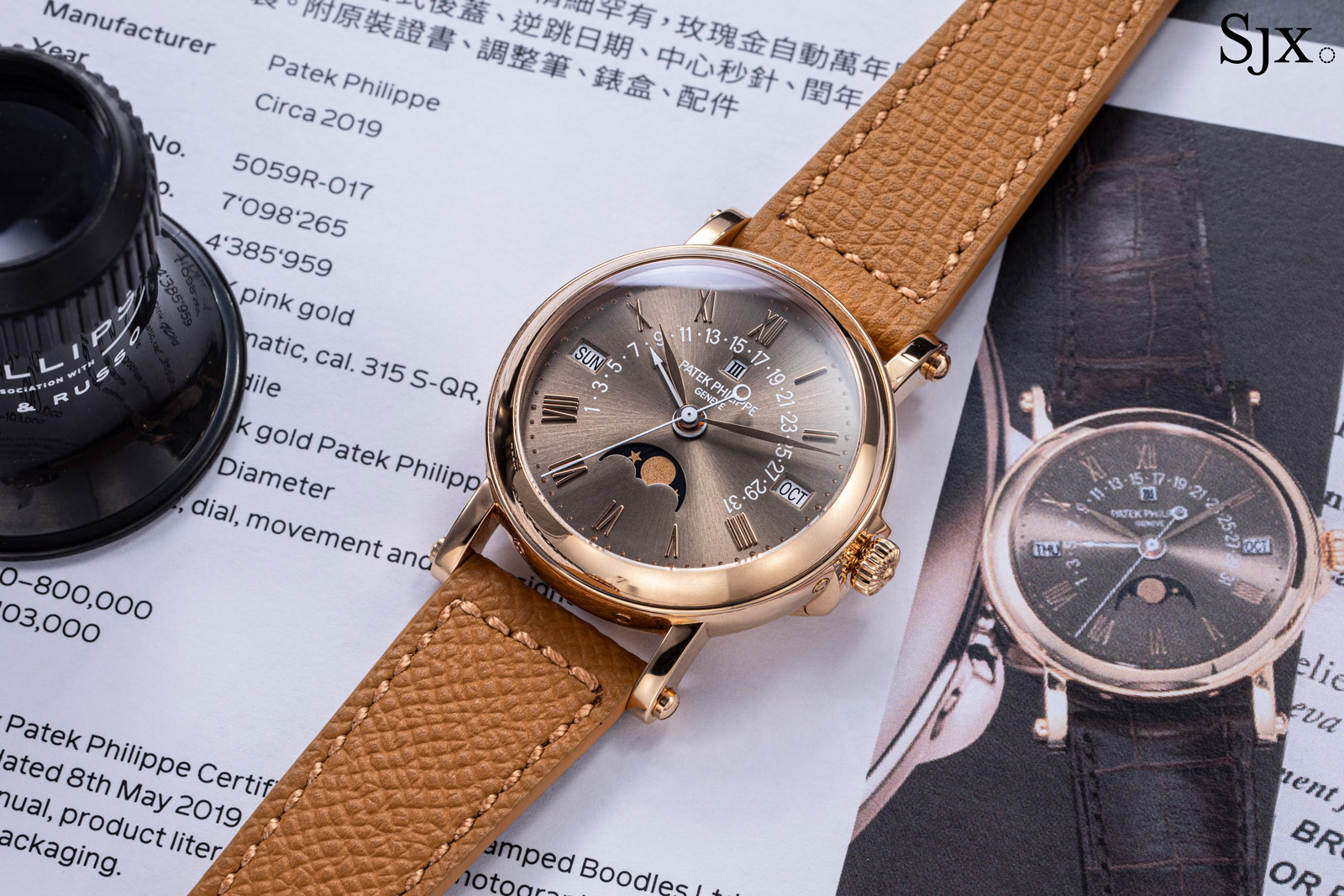
The Patek Philippe ref. 5059R made for the Grand Exhibition in London.
822 – Lange Zeitwerk Honeygold “Lumen”
Launched in 2021 to overwhelming demand, the Zeitwerk Honeygold “Lumen” was the A. Lange & Söhne’s second luminous digital-display watch after the “Phantom” of 2010.
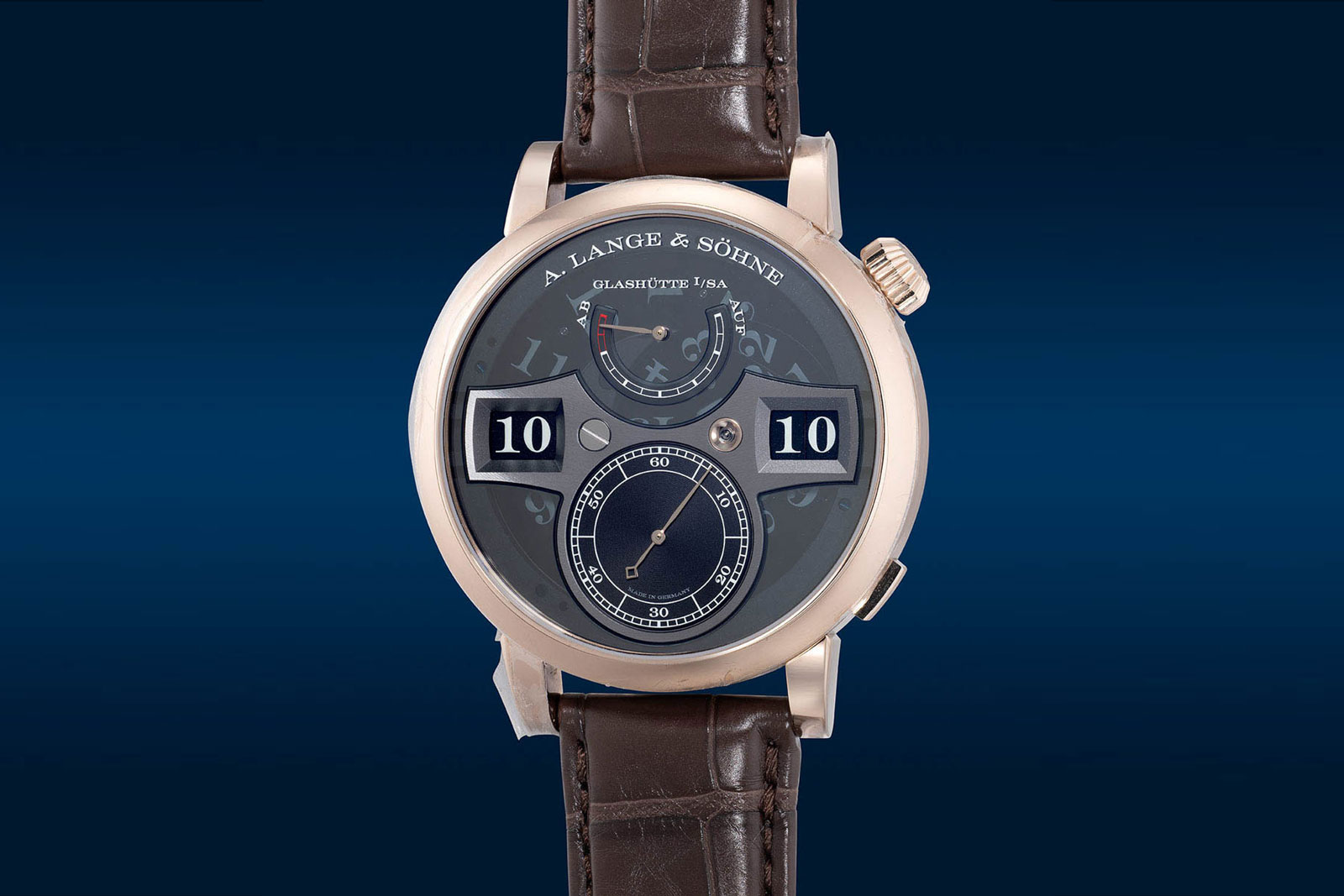
It was a limited edition of 200 watches and based on the second-generation Zeitwerk, which is visually almost identical to the original model but enhanced with several technical upgrades, including a longer, 72-hour power reserve.
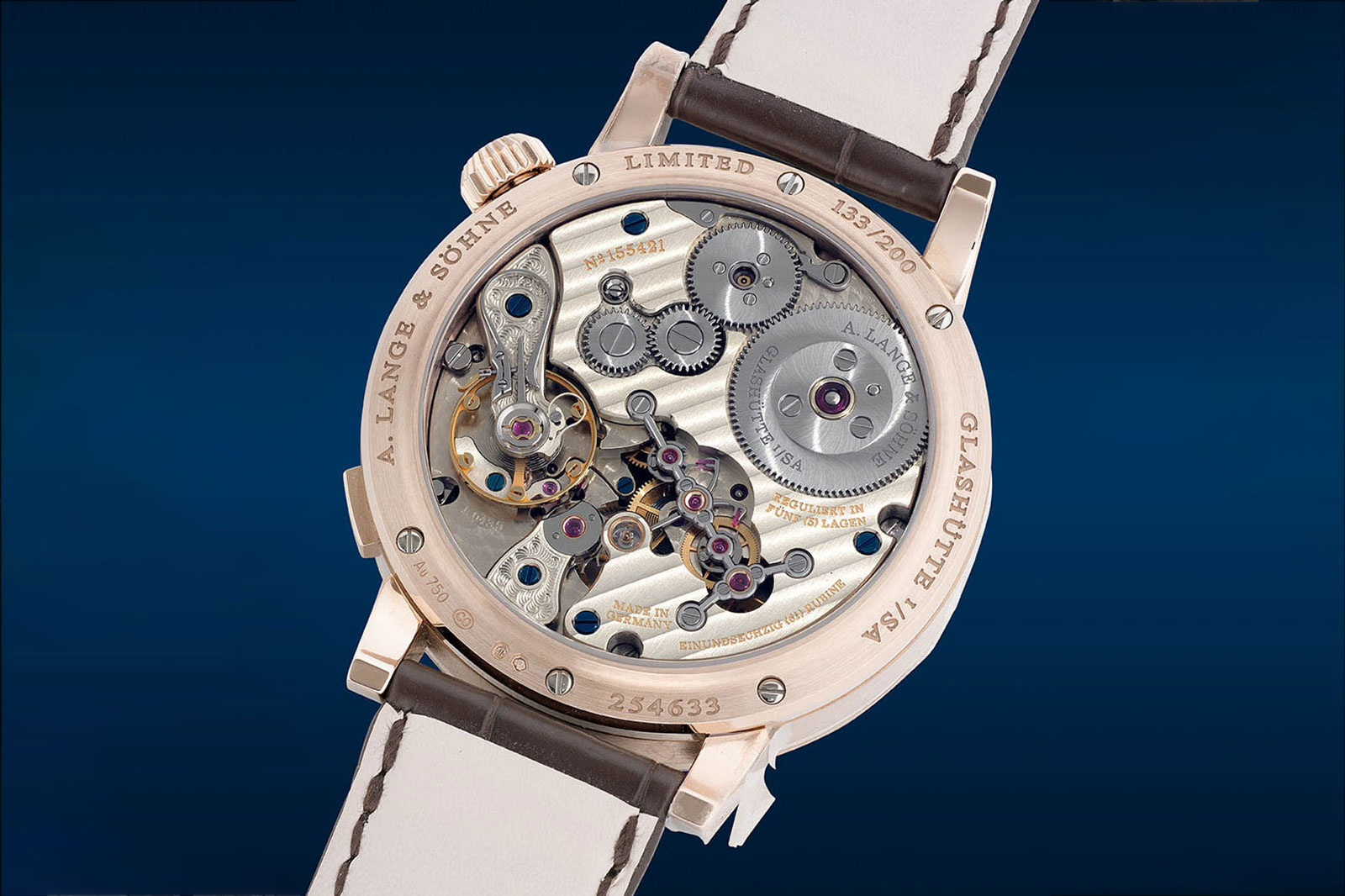
Like the earlier “Phantom”, the Zeitwerk Honeygold “Lumen” has a tinted sapphire dial that reveals the luminous numerals on the time display discs below. Its second distinguishing feature is the case in Honeygold, a harder-than-usual gold alloy Lange reserves for limited editions.
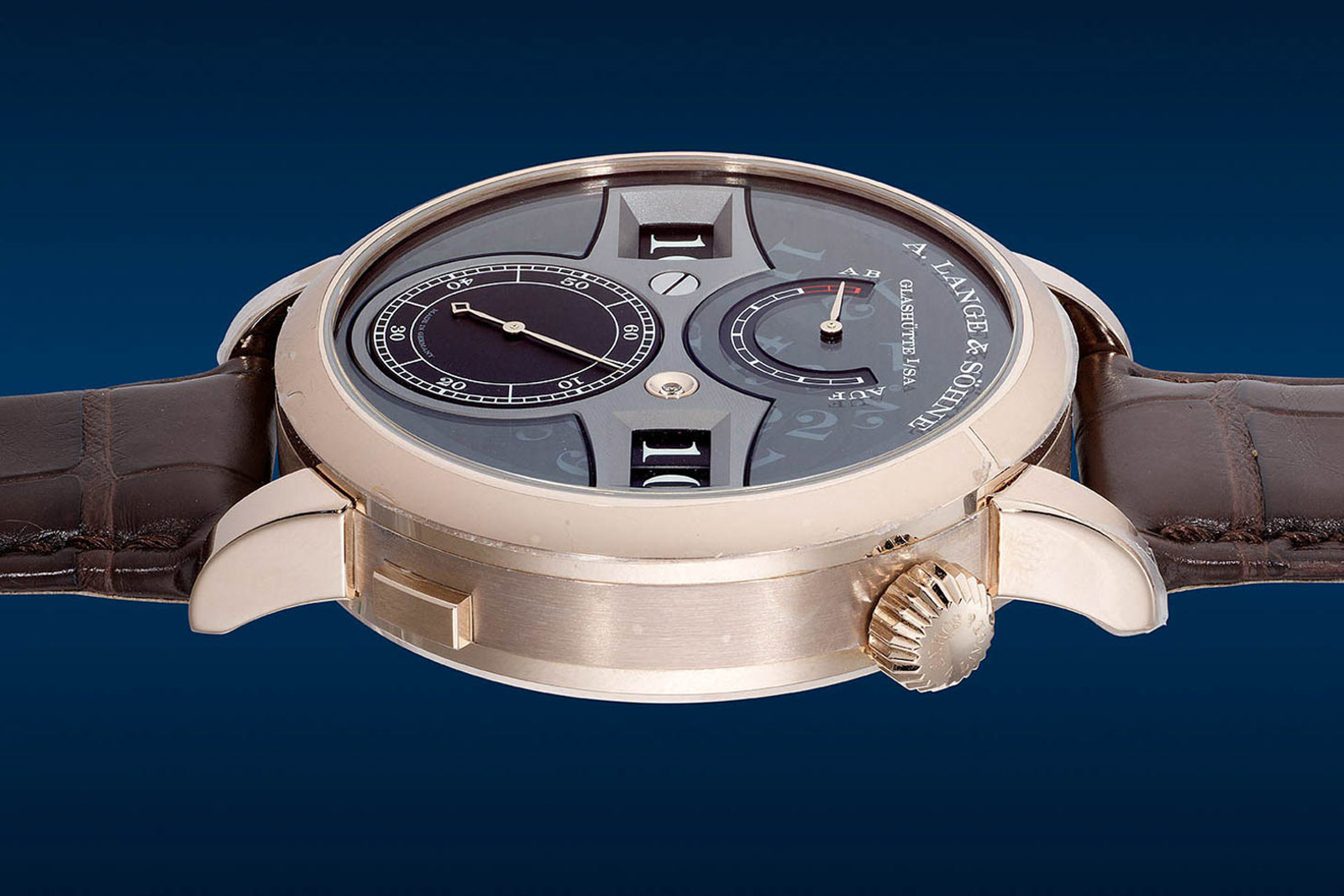
Both strong demand and the brand’s retail practices made the Zeitwerk Honeygold highly inaccessible. Though a handful have emerged on the secondary market, this is the first example to be sold at auction. And with the recent decline in secondary market values for Lange, this Zeitwerk has a low estimate under the original retail price (that has since increased substantially).
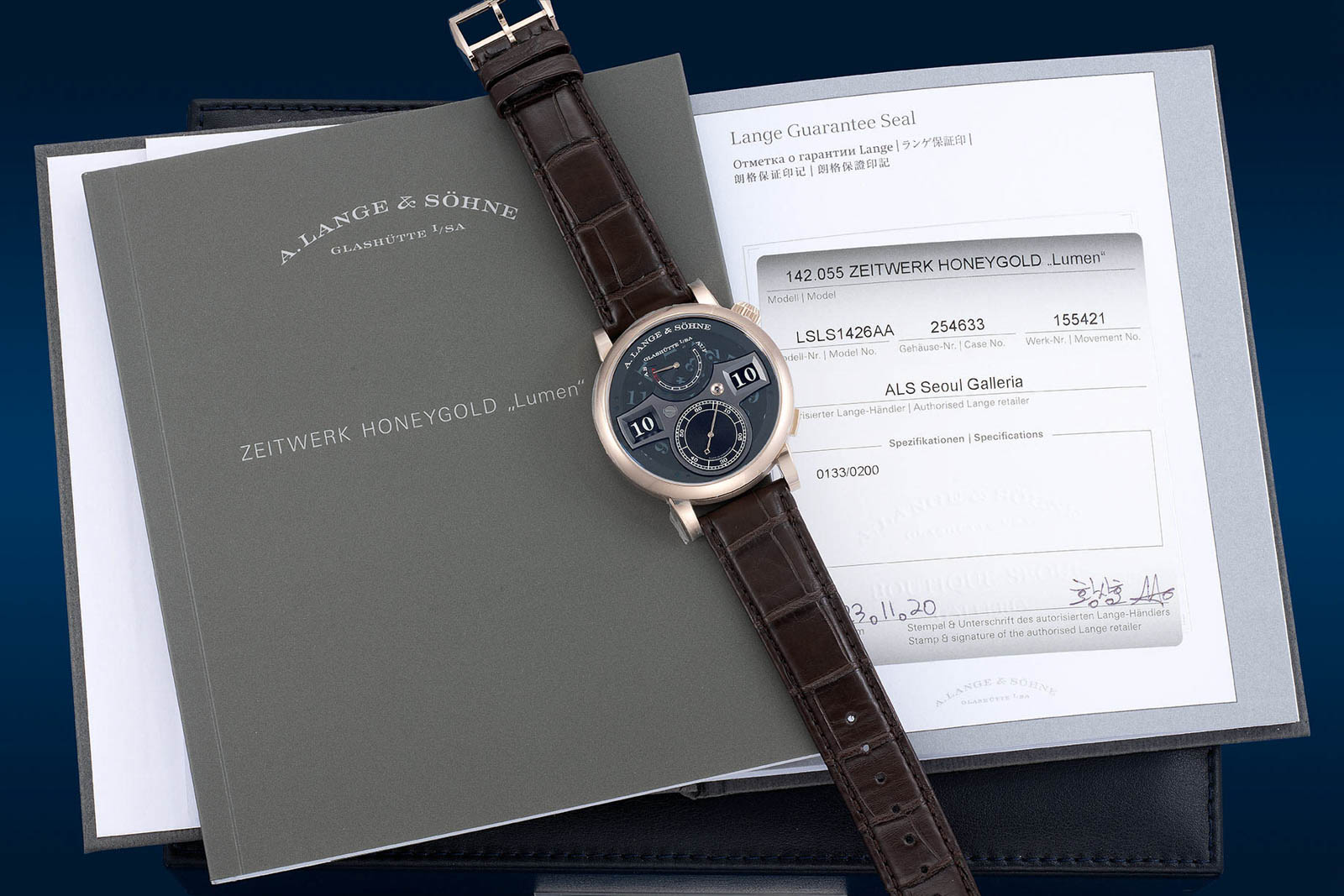
Practically new and sold just six months ago, the Zeitwerk Honeygold includes its original box and papers. The estimate is HK$780,000-1.50 million, or US$100,000-192,000.
873 – Breguet Tourbillon Perpetual Calendar ref. 3757BA
One of the most complicated tourbillon models made by Breguet, this is the ref. 3757 that builds on the familiar Lemania tourbillon calibre with the addition of a perpetual calendar sporting a retrograde date display.
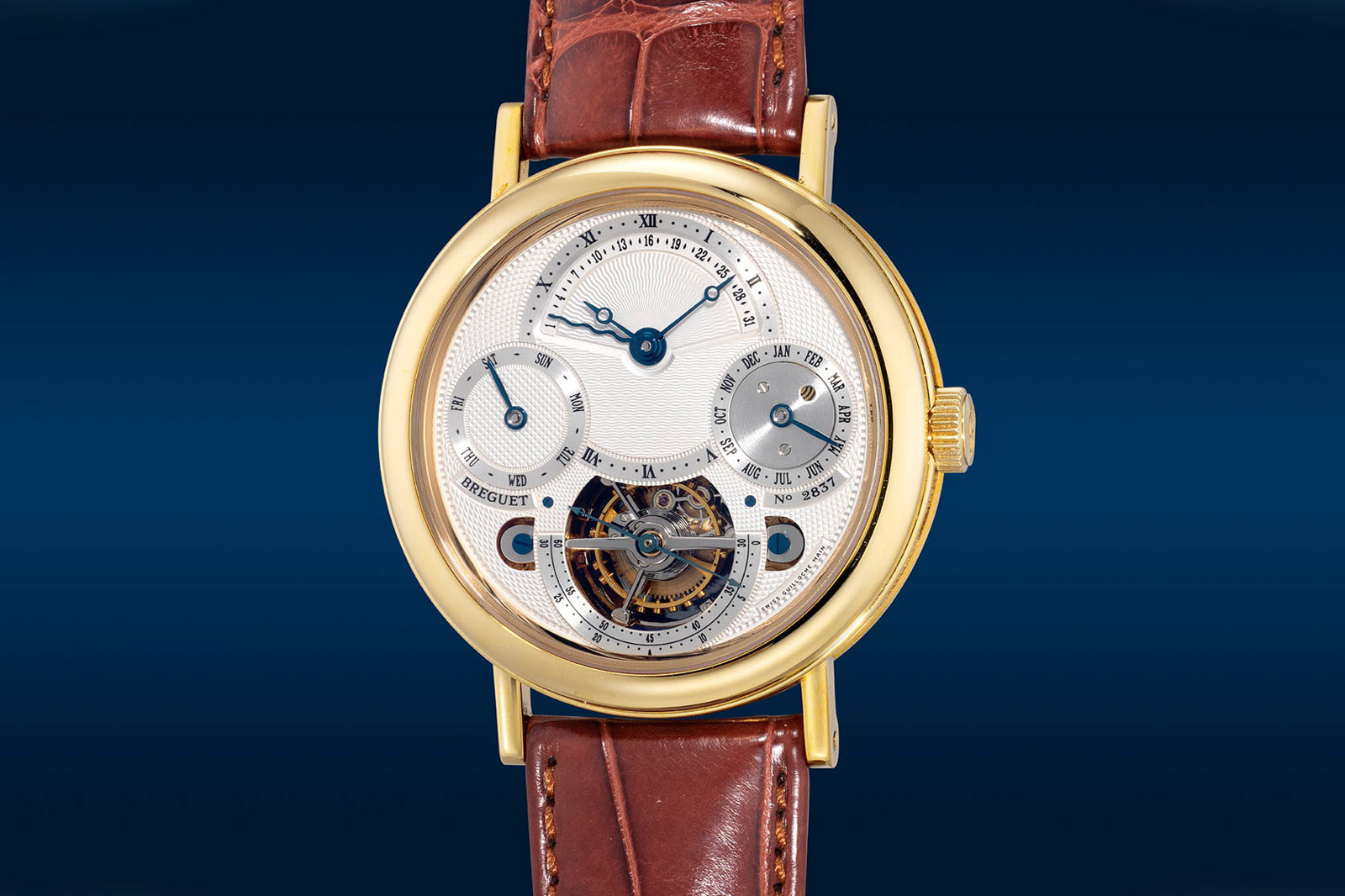
The silvered dial is symmetrical and decorated with several guilloche patterns, while the case is yellow gold – the classic Breguet look. In addition to the conventional Breguet hands, the retrograde date is indicated by an elegant serpentine hand. Interestingly, the dial is located one level above the tourbillon, which is a result of the added height of the calendar module.
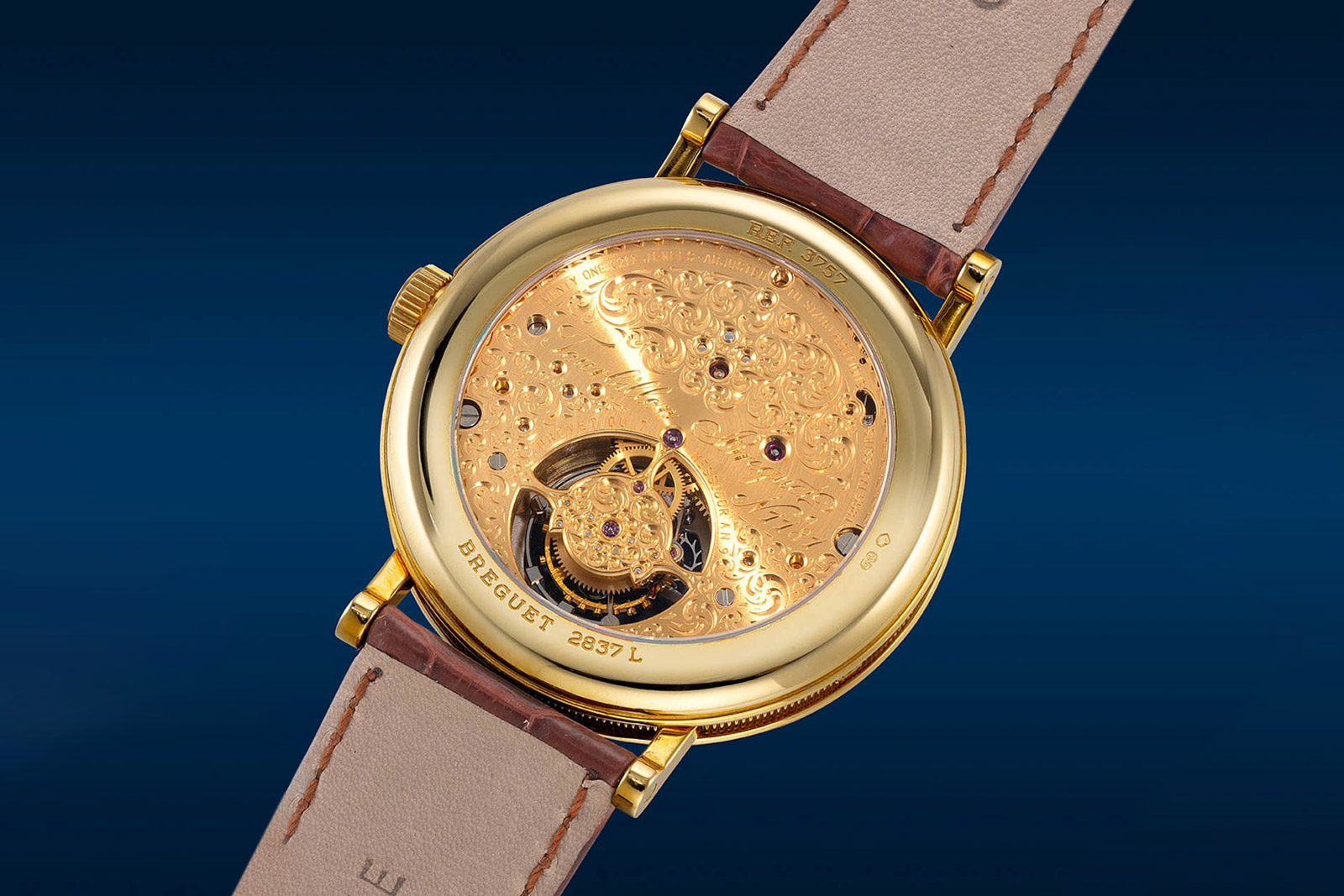
Like many Breguet tourbillon movements, this has a full plate on the back that is decorated with hand engraving, including the individual number of the tourbillon movement (which reveals Breguet has made quite a lot of them).
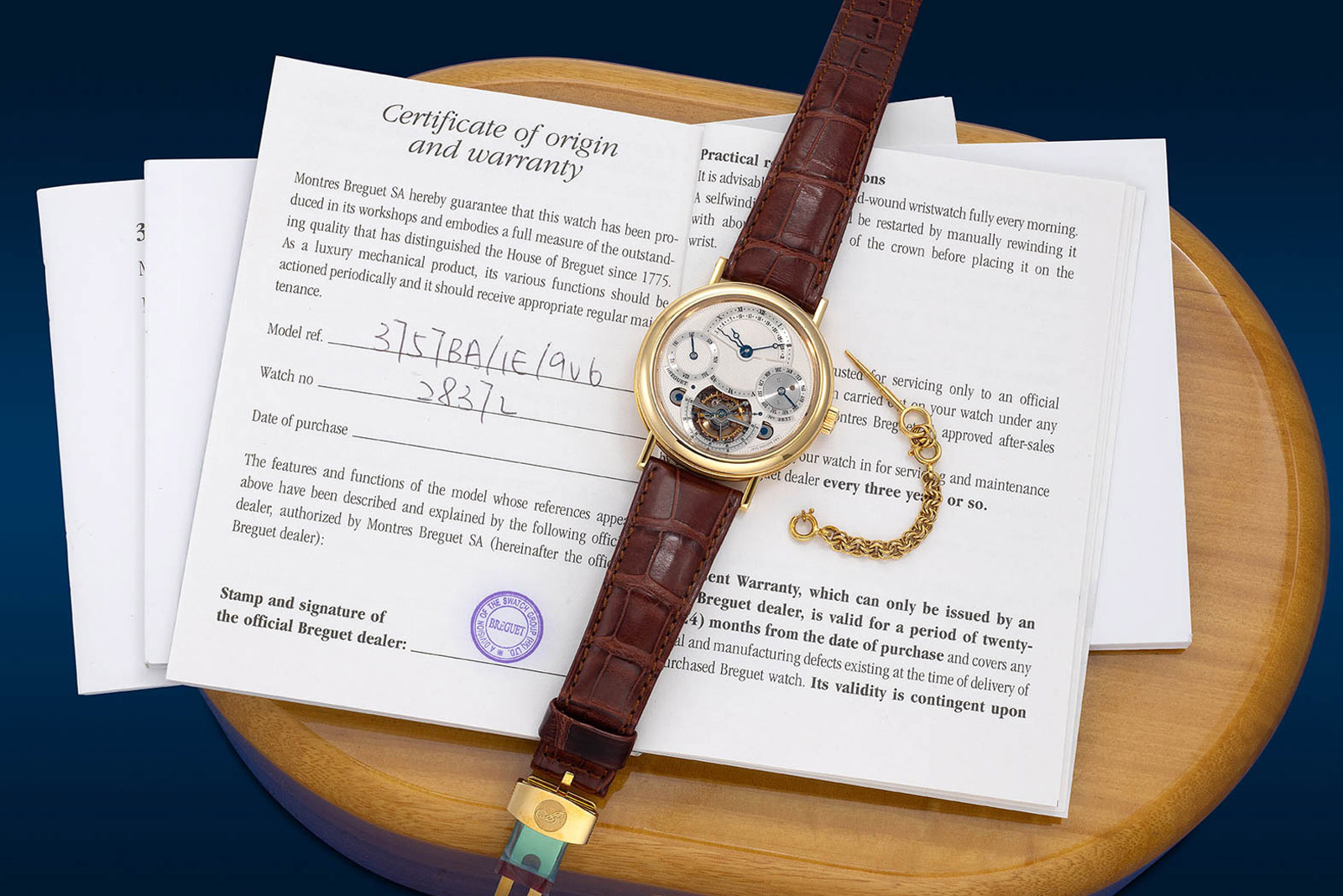
Originally sold 21 years ago, this Breguet is in “new old stock” condition and includes its original box and booklet. Like many Breguet tourbillon models, it presents good value with an estimate far below the current (and original ) retail price, of just HK$320,000-480,000, or US$41,000-61,500.
875 – Glashütte Original PanoMatic Tourbillon
Like the Breguet above, this Glashütte Original is a high-quality tourbillon wristwatch that was expensive when new but now notably affordable. In fact, this PanoMatic Tourbillon is even more affordable than the Breguet.
Launched in 2003, this was one of the first models in the brand’s Pano line (which was perhaps inspired by the Lange 1). A limited edition of 50 watches, it was one of the most expensive models in the line, featuring a platinum case, guilloche dial, and self-winding movement with flying tourbillon.
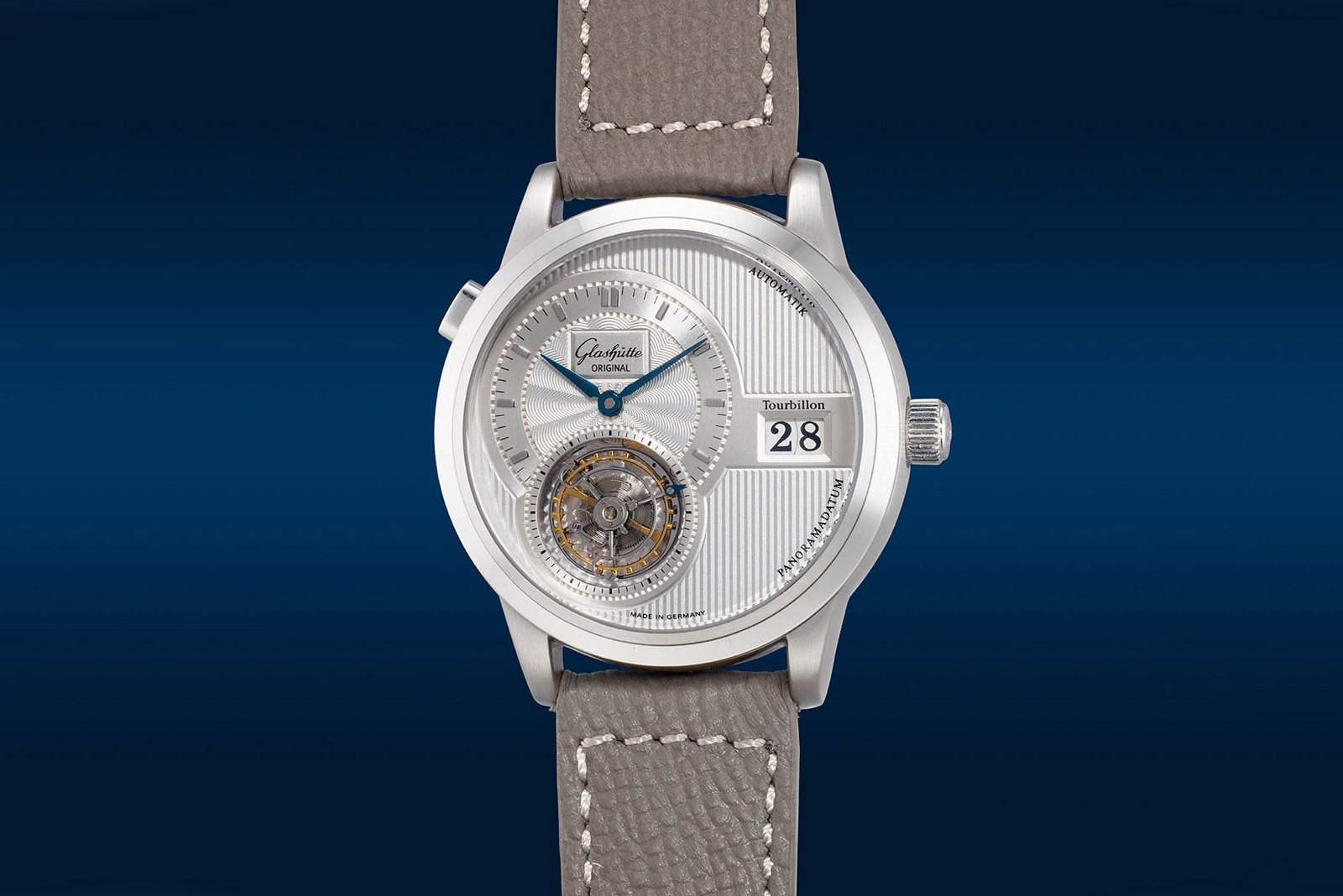
The movement is unusual in its combination of complications – tourbillon, automatic winding, and oversized date – while the execution is recognisably German in style. Finished with striping, blued screws, and sporting rubies in gold chatons, the full plate on the back houses a micro-rotor with a solid gold rim. Additionally, the text on the rim of the case back is hand engraved.
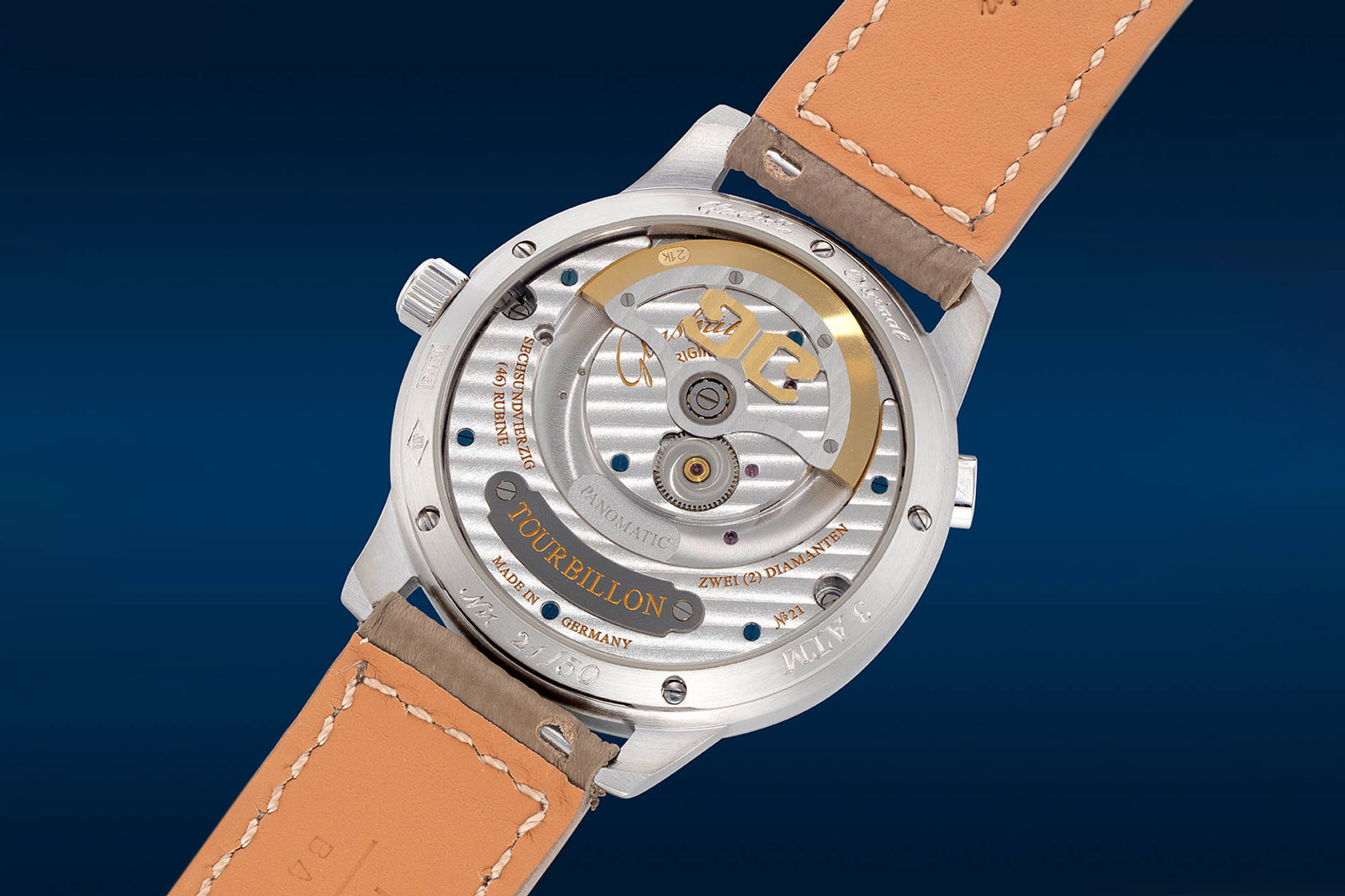
The tourbillon in particular is a historical tribute: it’s modelled on the first-ever flying tourbillon invented by Glashütte watchmaker Alfred Helwig. Not only does the cage take the same form as Helwig’s original, it has diamond endstones for each pivot of the balance staff.
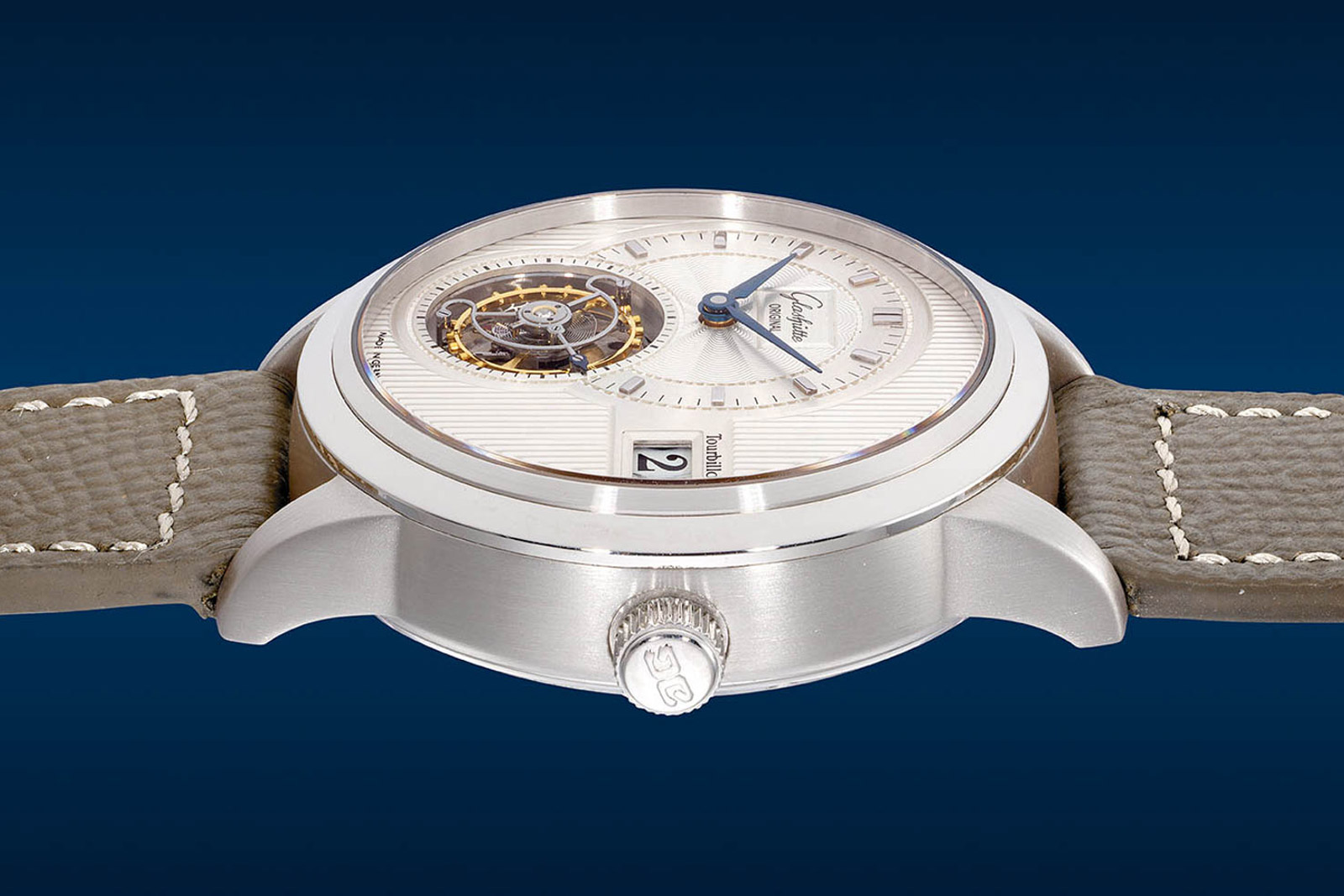
Complete with the original box and papers, the PanoMatic Tourbillon has an estimate of just HK$120,000-240,000, or US$15,400-30,800.
880 – Patek Philippe Ref. 5059R-017 London Edition
This is an example of Patek Philippe’s top-of-the-line perpetual calendar in the late 20th century (that distinction now goes to the ref. 5236P linear calendar), the perpetual calendar with retrograde date.
The lineage began with the ref. 5050, the brand’s first perpetual calendar with centre seconds after the ref. 2497 and 2438-1 of the 1950s and 1960s. In 1998, the ref. 5050 was succeeded by the functionally identical ref. 5059, a more modern but still classical watch with an officer’s case featuring a hinged back.
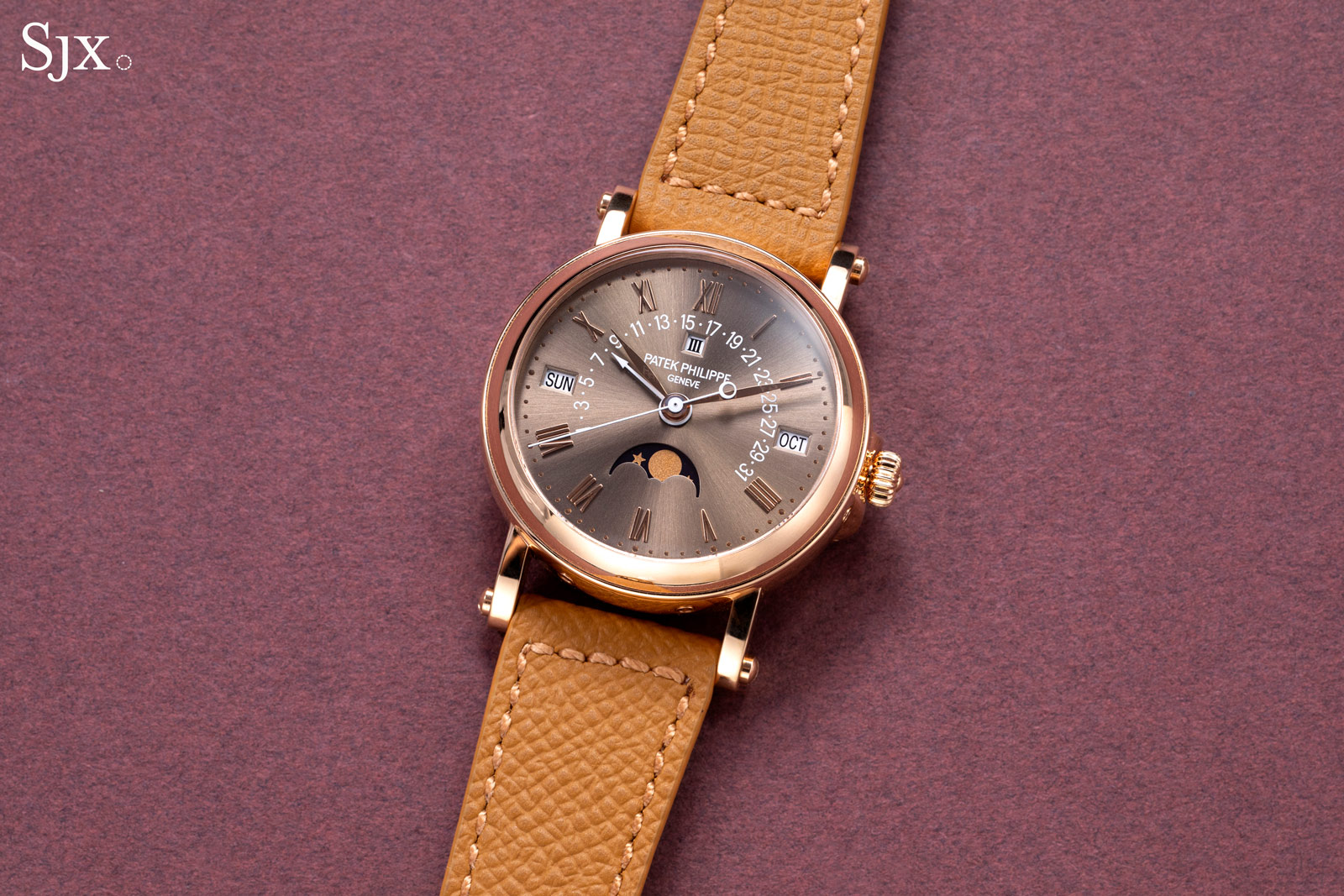
This version is a limited edition made for the Watch Art Grand Exhibition in London that took place in 2015. The pink gold case places its amongst the rarest case metals for the model, which was made from 1998 to 2006, with 1200 to 1400 estimated to have been made in all metals. The number in pink gold is believe to be between 300 to 400.

But it’s the dial that really makes this special. Finished with sunburst brushing and a metallic brown, the dial has applied numerals, a feature unique to limited edition or special order variants of the ref. 5059. The standard versions of the model all featured printed numerals.
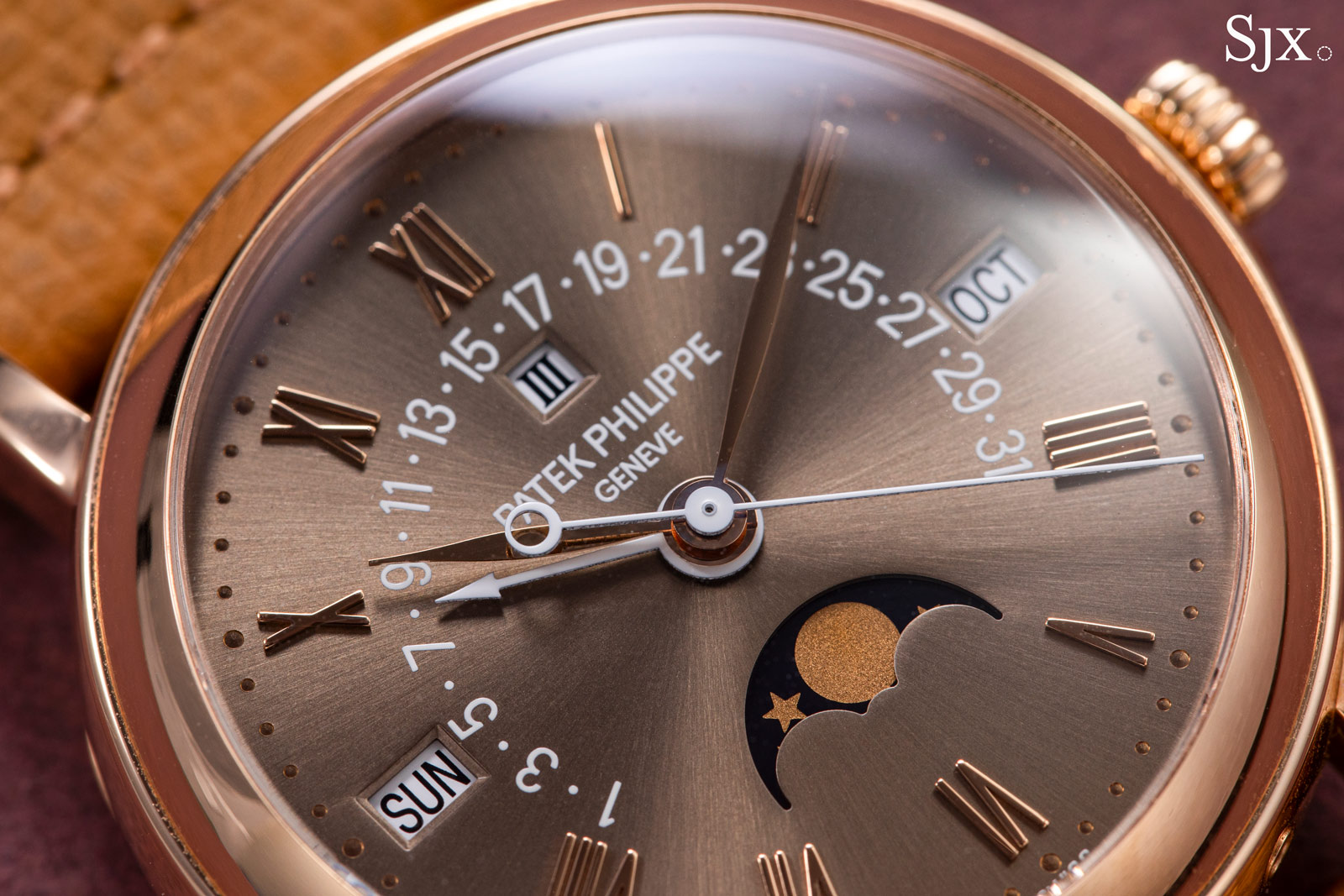
While the exact number of this edition is not known, only a few were made. This is only the second example of this version to emerge at auction. The first example was sold at Phillips last year for HK$635,000 including fees.
Maintained in exceptional condition, the ref. 5059R is a full set with box, papers and accessories. It has an estimate of HK$400,000-800,000, or US$51,300-103,000.
914 – Omega Tourbillon 30 I
The first-ever Swiss-made tourbillon movements for wristwatches came far earlier than most would think: in 1947 Omega made a dozen cal. 30 I tourbillon movements with an unusual carriage rotation of 7.5 minutes instead of the traditional 60 seconds.
Seven of the movements were submitted for testing at the Geneva, Neuchatel, and Kew-Teddington observatories over several years starting in 1947 until 1952. In 1950, the cal. 30 I numbered “10’595’933” earned an outstanding score of 867.7 points, the highest-ever result in the category.
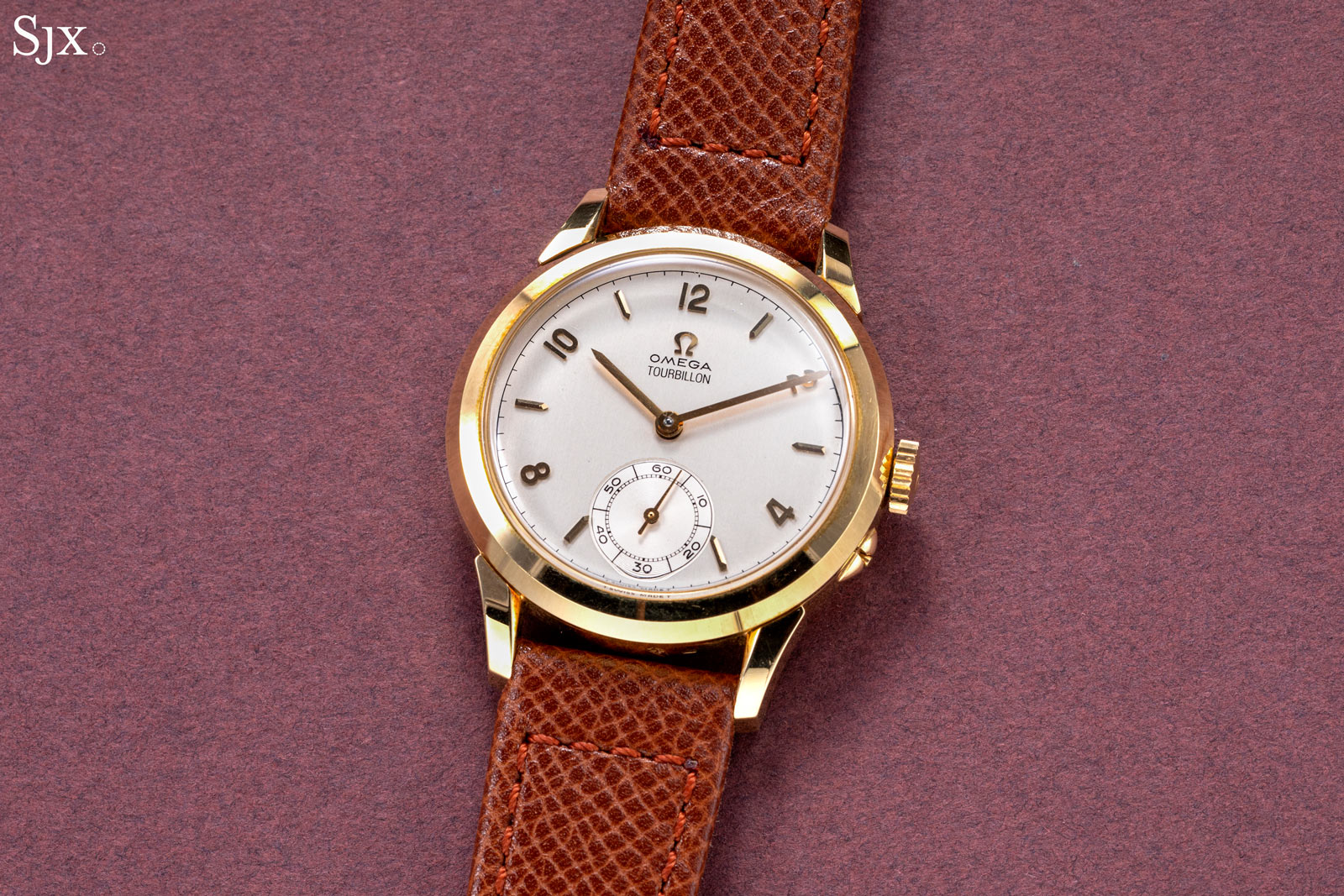
The movements submitted for the observatory competitions were never offered for public sale, instead they were used in marketing materials to emphasise Omega’s status as a leading chronometer maker. One movement, however, was transformed into a prototype wristwatch, making it the first Swiss-made tourbillon wristwatch, and in 2017 it sold for over US$1.4 million.
The watch on offer here is a more recent example, part of a batch of seven of movements that were rediscovered, decorated, cased, and sold in 1987.
This bears movement number “10’595’943”, or ten digits removed from the record-setting example tested in 1950. It was the second-t0-last movement made and tested at the Neuchatel observatory in 1947.
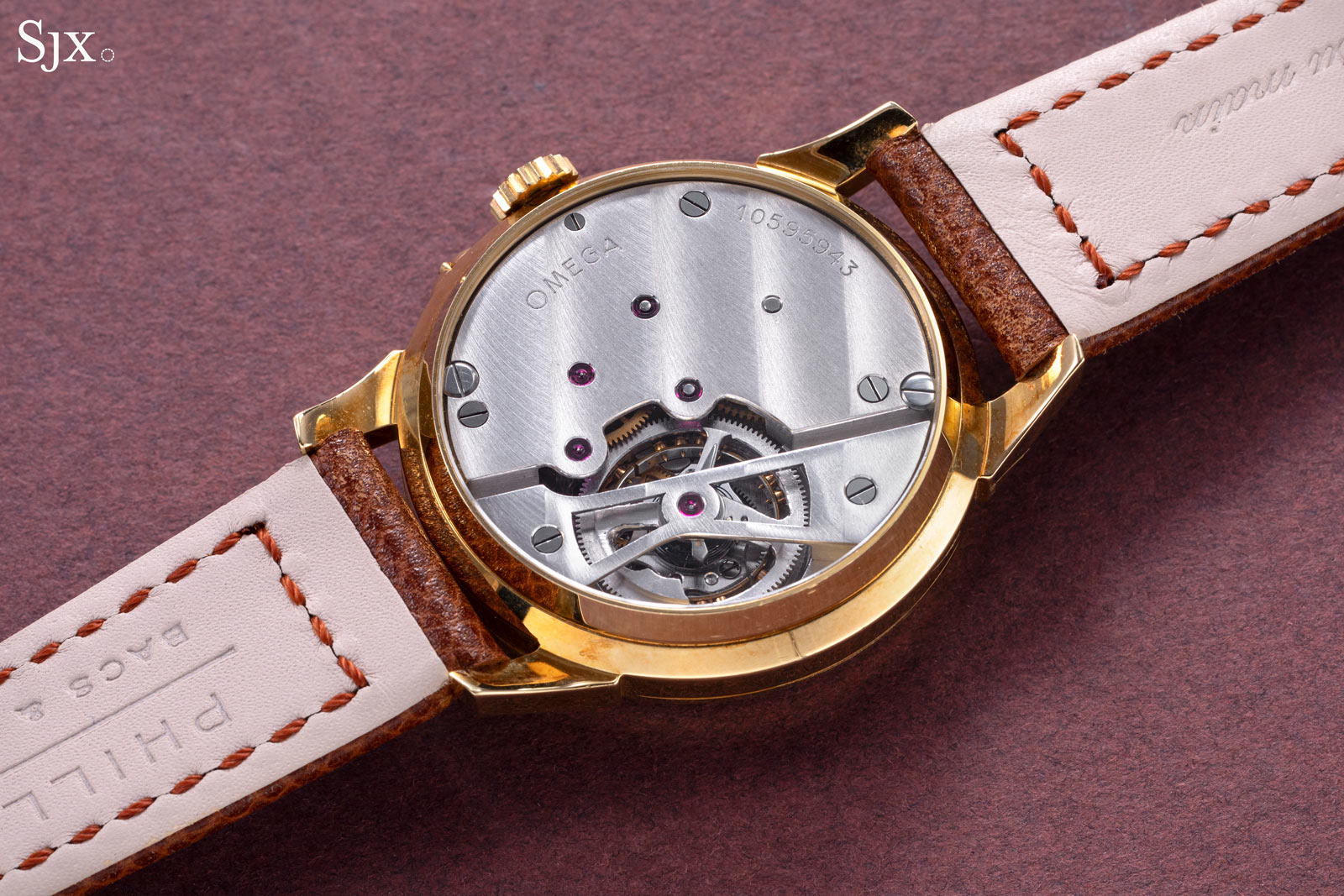
The cal. 30 I reveals the tourbillon only from the back, where the view is surprisingly plain. Having been constructed as observatory trial contestants rather than luxury watches, the cal. 30 Is were all basic in fit and finish, as revealed by the original prototype.
The seven examples cased in 1987 were reworked to dress them up for public sale, so this example features some decoration on the movement like Geneva stripes on the bridges.
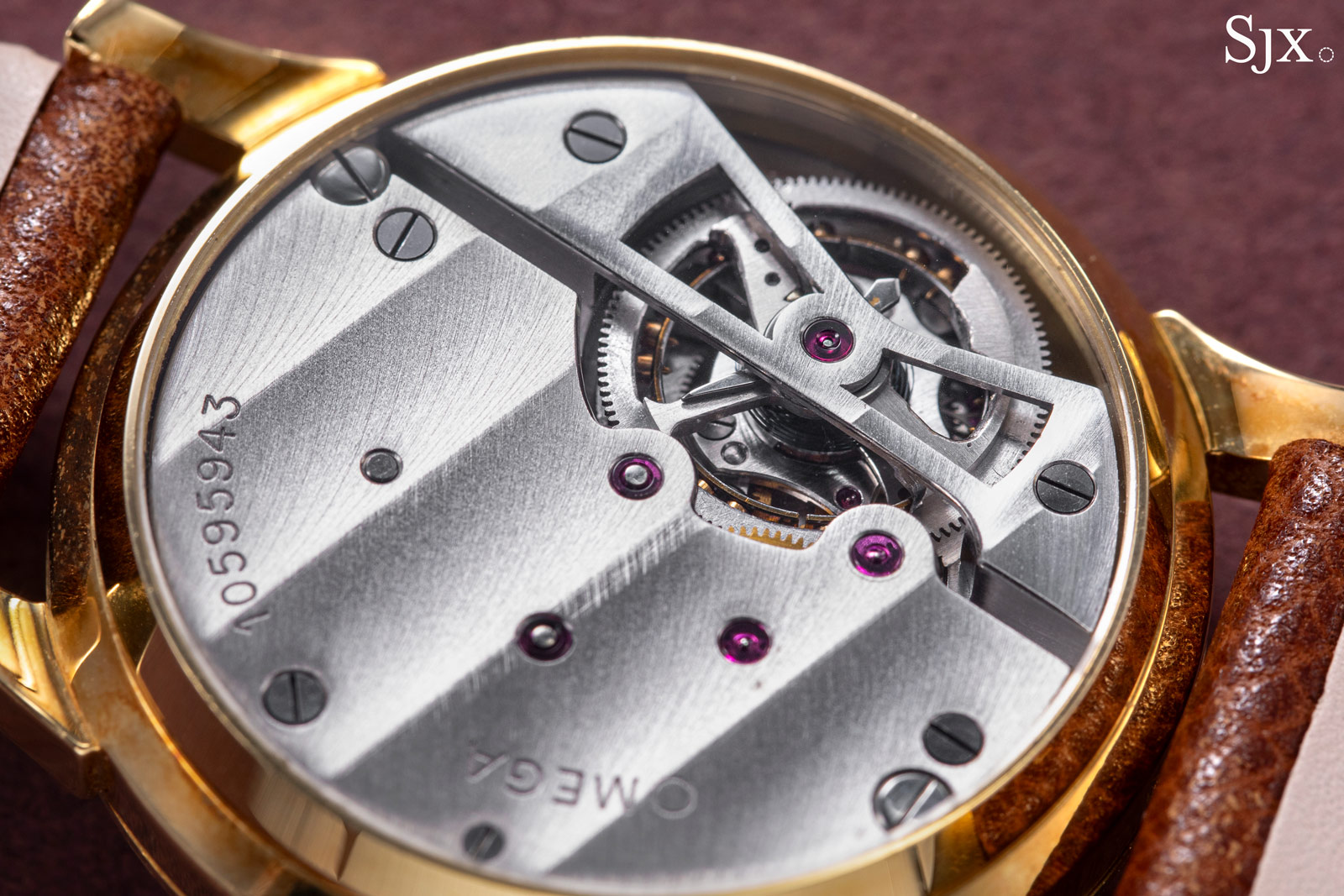
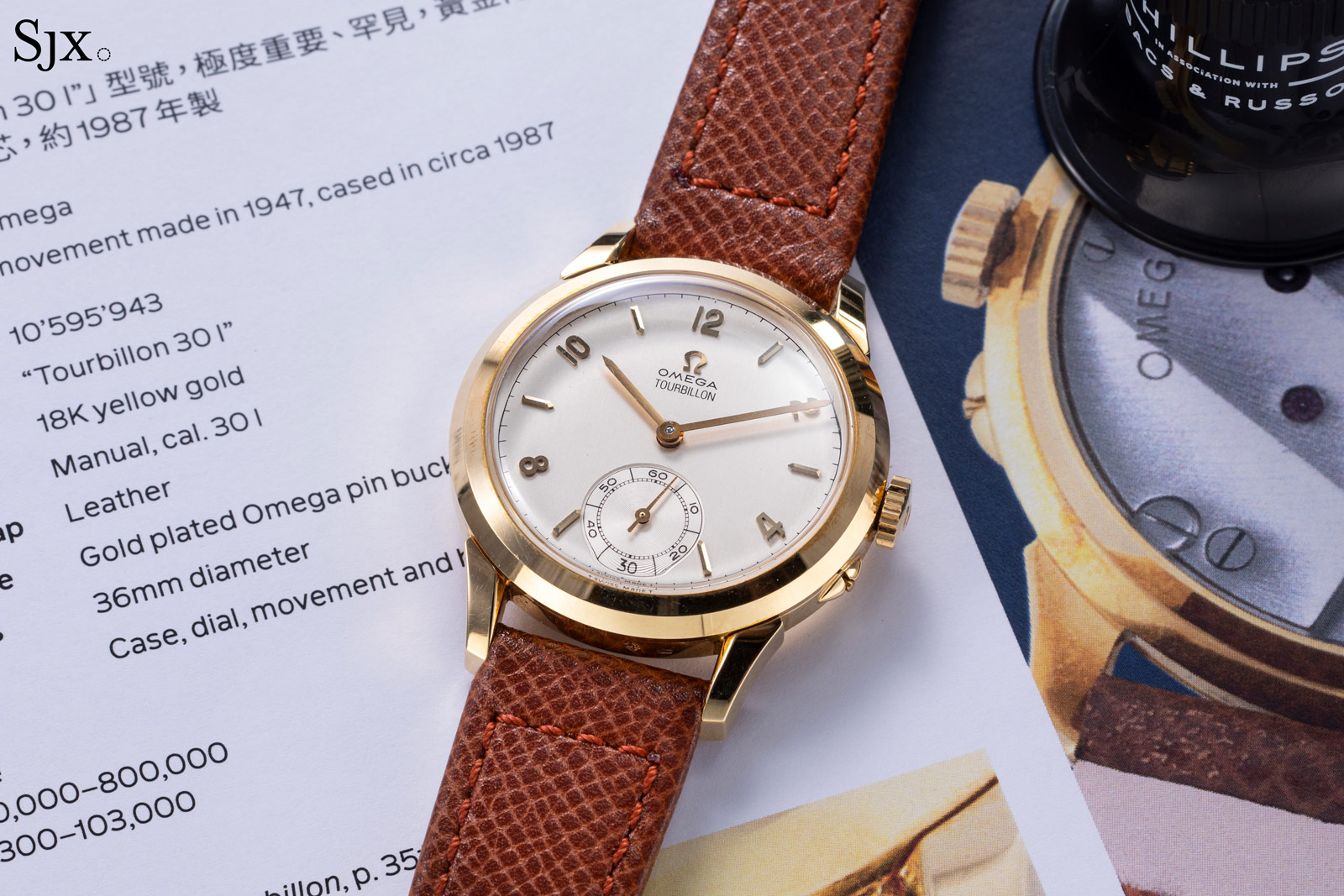
This watch has been in the same collection for 35 years and is in outstanding condition. It is estimated at HK$400,000-800,000, or US$51,300-103,000.
929 – Excelsior Park Split-Seconds Chronograph Venus 179
A vintage revival in both name and movement, this Excelsior Park rattrapante chronograph contains a vintage Venus 179 split-seconds chronograph movement. Although the brand name has been recently revived, this watch is from an earlier incarnation of the company and dates to the 1990s.
Excelsior Park was one of several brands that turned to similar “new old stock” split-seconds movements in the late 1980s and 1990s – other brands that utilised the same movement were Girard-Perregaux, Parmigiani, and Franck Muller – to create vintage-style watches with classical complications.
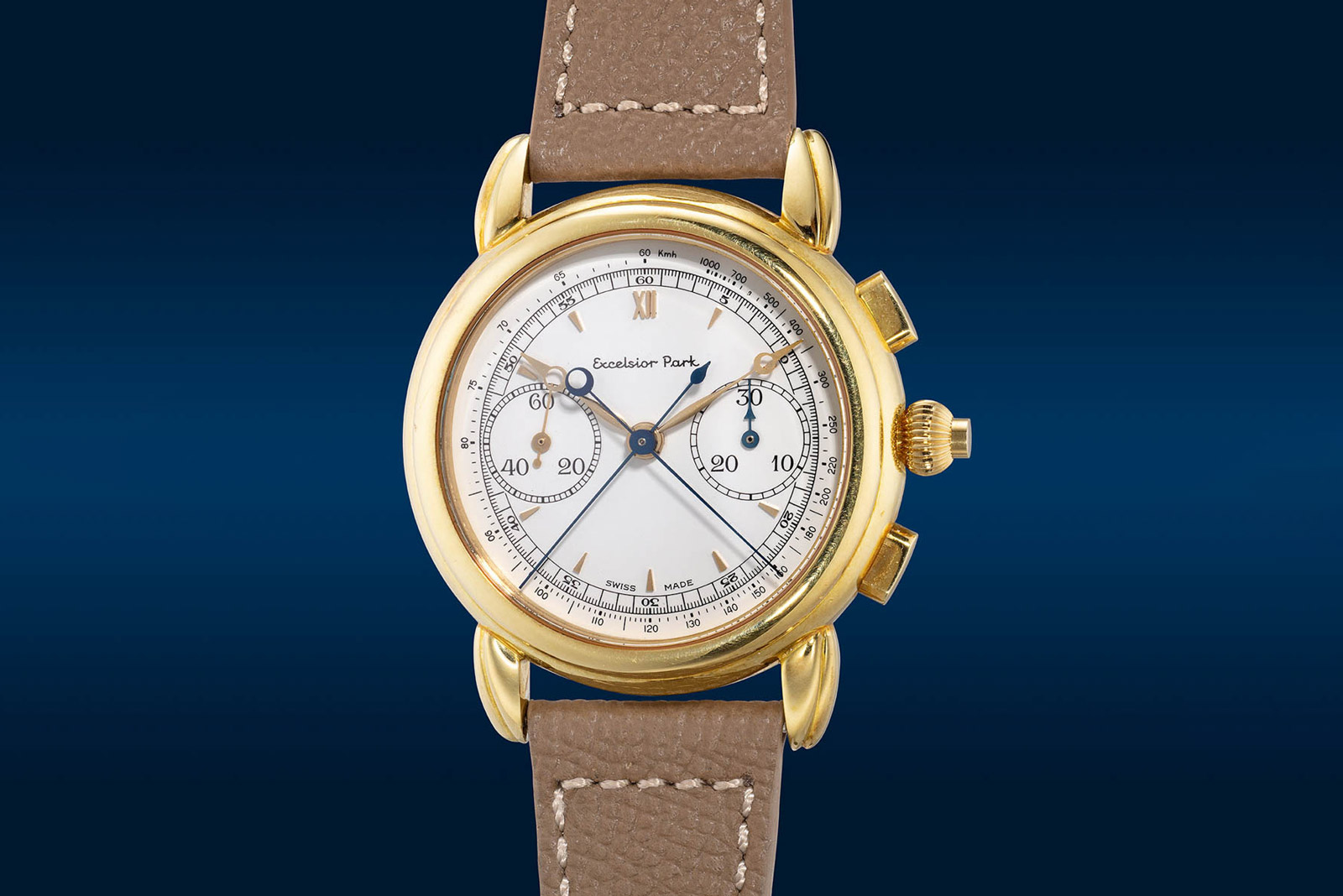
The Venus 179 is a well-known rattrapante calibre constructed in the traditional style, with a column wheel and lateral coupling for the chronograph, and an additional seconds wheel with a pair of clamps for the split seconds. Produced in the 1950s and 1960s, it’s best known for being found inside the Breitling Duograph.
Here the split-seconds are displayed with a pair of blued steel hands, each with a differently shaped counterweight. They are matched by a blued steel minute counter hand, while the hands for the time are in gilt.
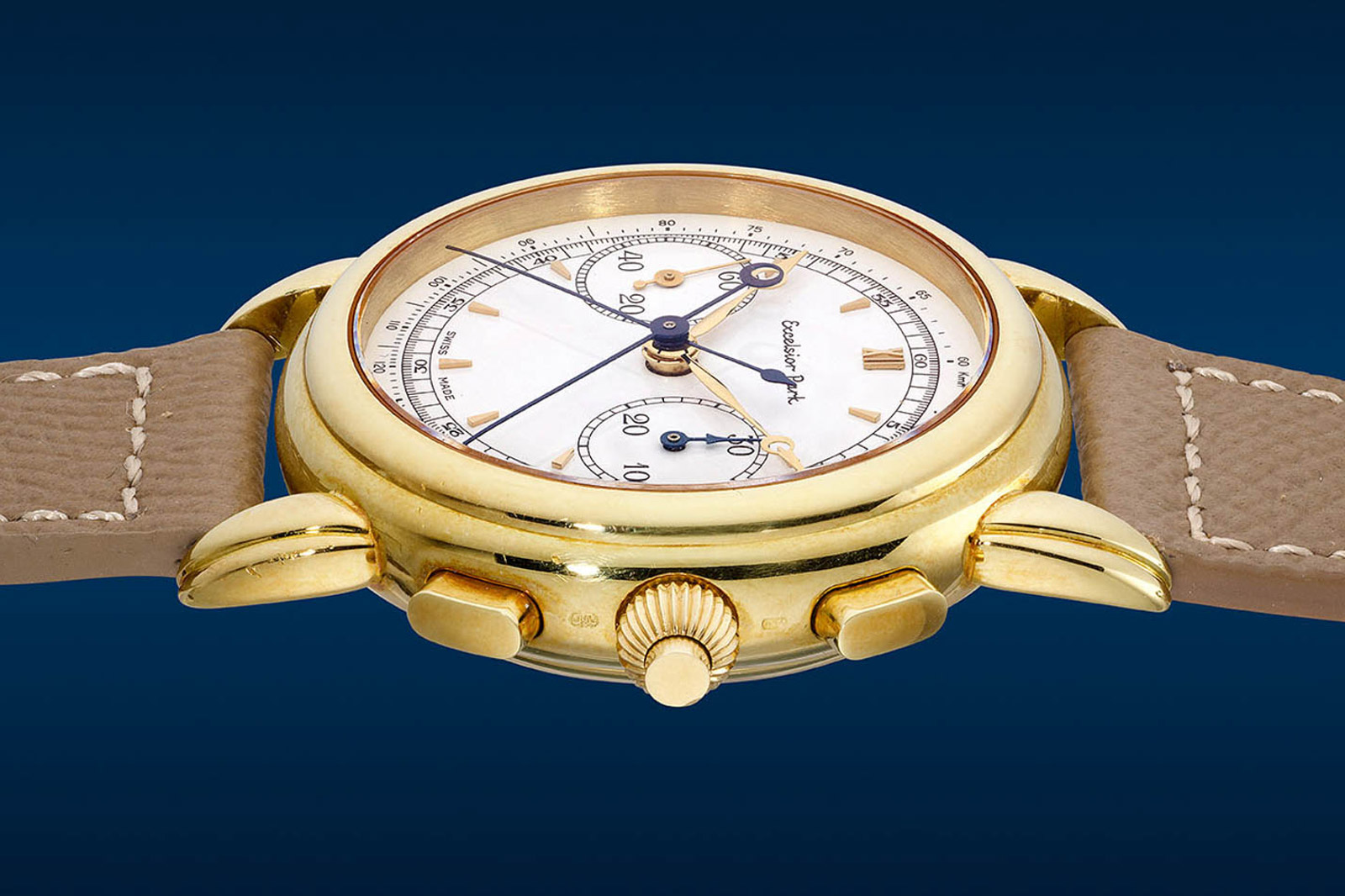
The movement is visible through the open back of the yellow gold case, which is a compact 39 mm in diameter. The snap-on back also features the hand-engraved brand name and serial number.

This Excelsior Park is amongst the most affordable traditional, high-end rattrapante chronographs, with an estimate of just HK$48,000–95,000, or US$6,200–12,200.
996 – Audemars Piguet Jules Audemars Minute Repeater Supersonnerie
Audemars Piguet is best known for the Royal Oak, but it’s the best value with almost anything else but the Royal Oak. It’s a Minute Repeater Supersonnerie with a platinum case, fired enamel dial, and a low estimate well under a third of the retail price.
Moreover it’s a Supersonnerie, which means it employs AP’s case construction system based on three patents, including one for a second case back that functions as a soundboard. The result is perhaps the loudest and most resonant minute repeating wristwatch on the market. It’s made all the more notable by the heavy platinum case, which would ordinarily be a detriment to the sound.
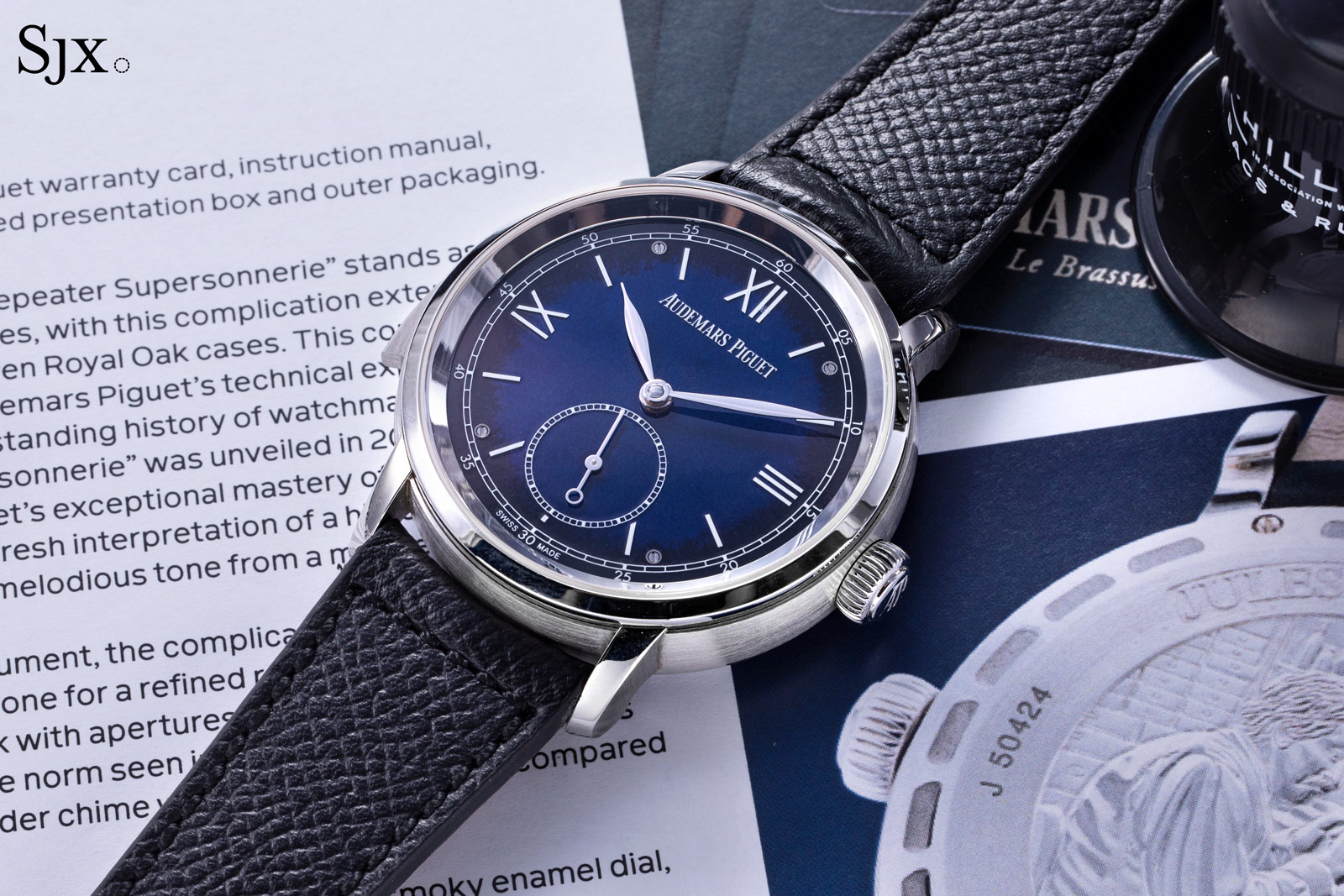
More classical in style than the Code 11.59, the Jules Audemars line was AP’s classic, round-watch offering for almost two decades. This repeater is typical of the design, with polished bezel and lugs matched with a brushed case middle.
The aesthetic is restrained with a grand feu enamel dial in a smoked finish that’s a dark blue in the centre that darkens to black at the edges.
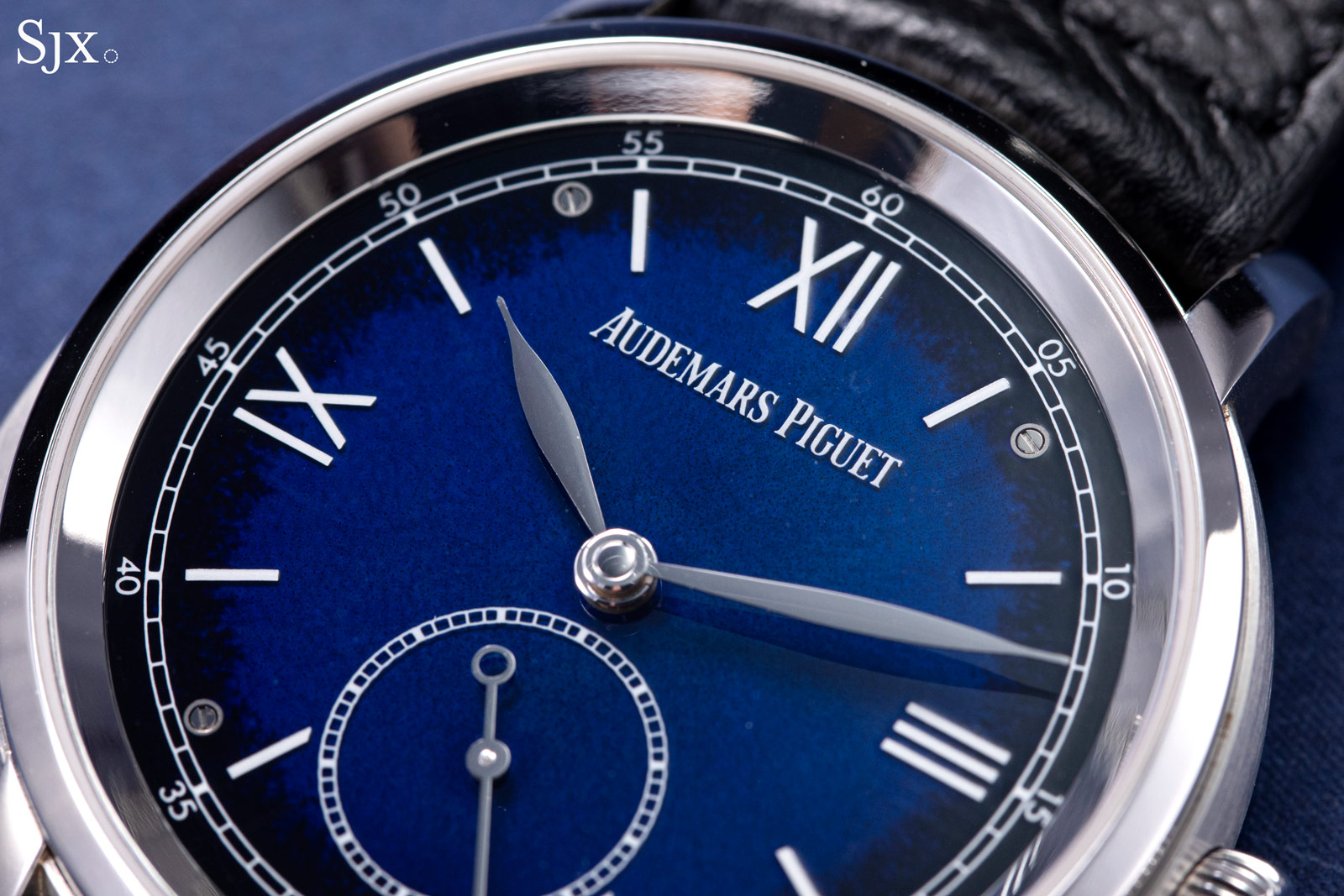
The watch is fairly large at 43 mm in diameter and 13.16 mm thick, which is a consequence of the Supersonnerie construction that requires a double case back as well as substantial open space within the case for resonance.
The case back has perforations around its rim to allow sound to be transmitted outside the case, another feature of the Supersonnerie. It’s also decorated with cast relief of a watchmaker at a bench.
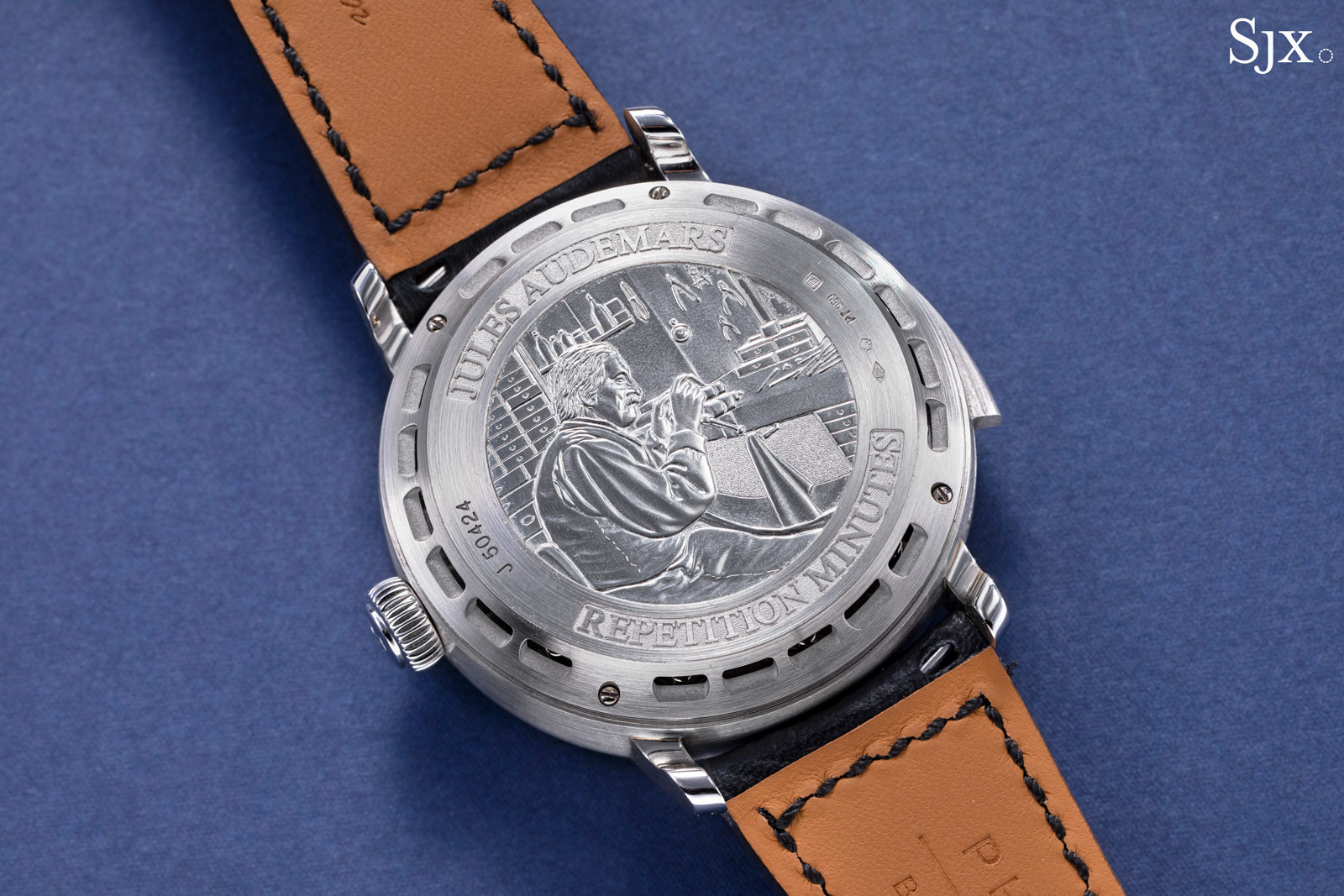
The Supersonnerie is in like-new condition and is presented with its box, papers, and accessories. The estimate is HK$780,000-1.56 million, or US$100,000-200,000.
1002 – Montblanc Minerva Villeret 1858 Grand Chronographe Émail Grand Feu
Produced just over a decade ago when Montblanc had much grander ambitions in watchmaking, this Minerva-powered chronograph was elaborately executed inside and out.
It was part of the Villeret 1858 line of watches with hand-finished movement, hand-made enamel dials, and notably heavy gold cases, all of which resulted in unusually high retail prices. As is often the case with such watches, this is being offered with an estimate that’s a fraction of its original retail.

The heavy 18k pink gold case has a hinged hunter back that reveals the hand-finished Minerva cal. 17-29, a beautifully constructed single-button chronograph movement.
Like all Minerva movements of the period, it sports several decorative flourishes like spiral graining on the winding wheels and a “devil’s tail” on the chronograph levers.
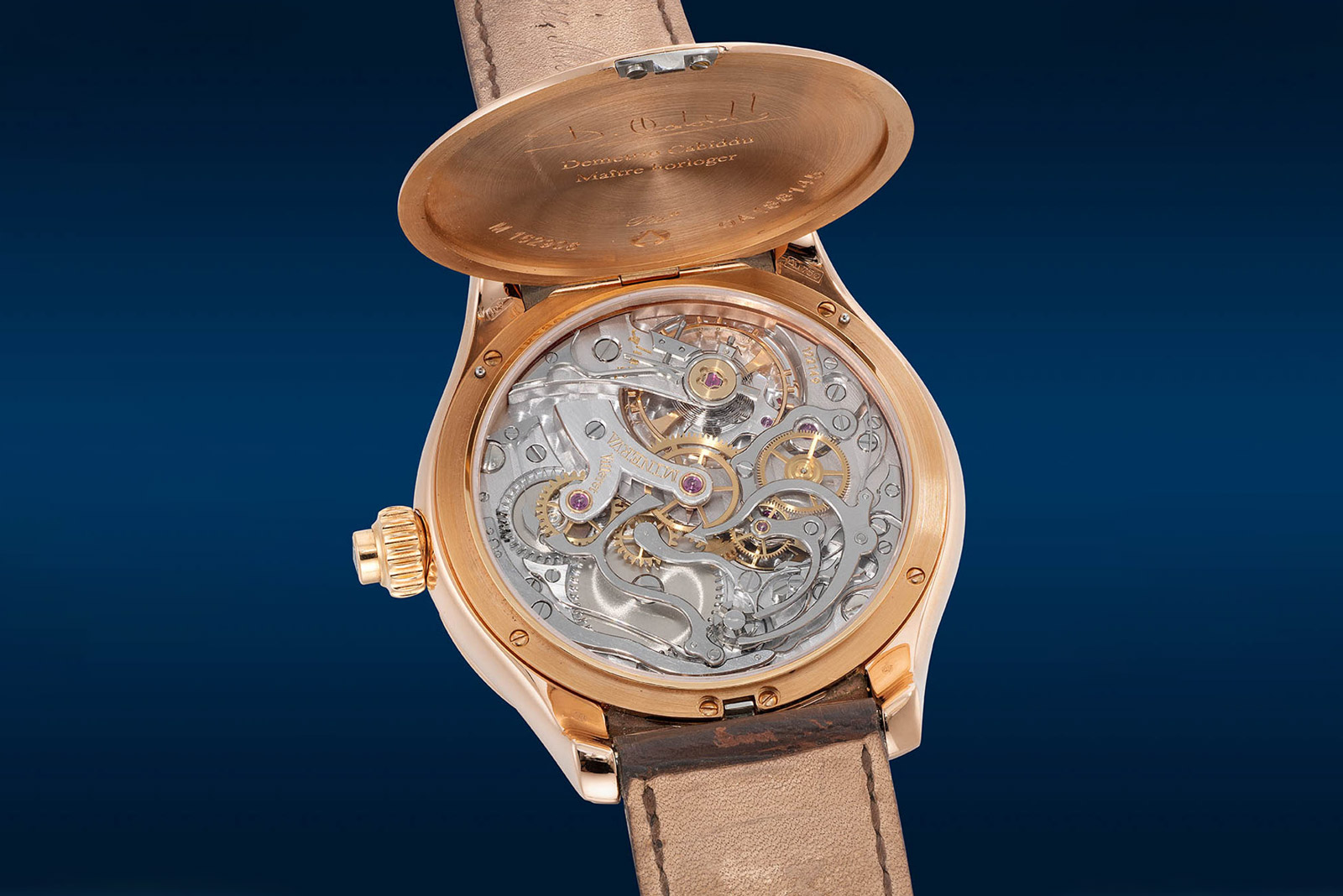
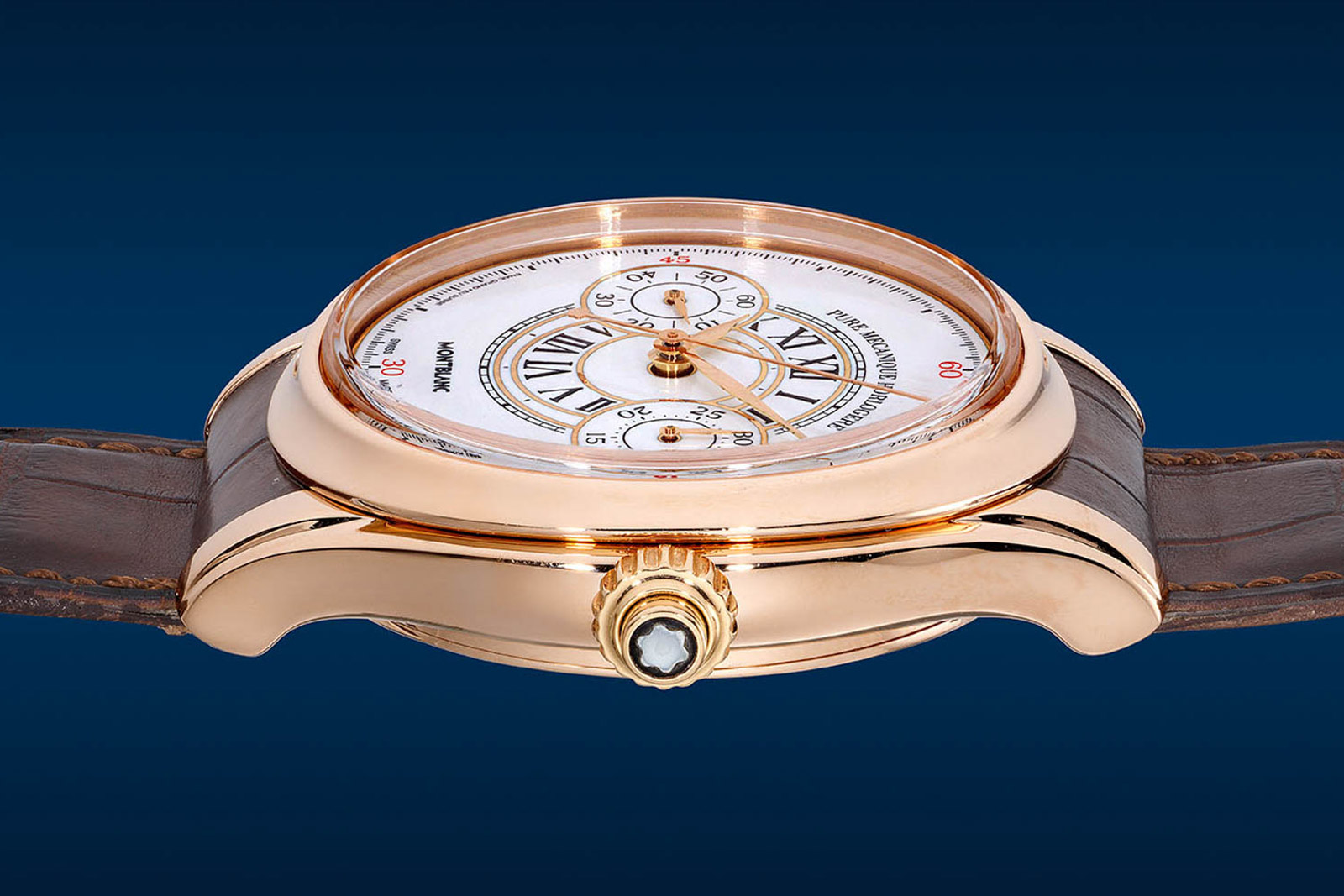
The dial is equally artisanal – a solid gold case finished with champleve enamel. The dial base was first engraved to create relief borders for the chapter ring and registers, the resulting recesses filled with white enamel that was then fired. Then the dial was lapped for a smooth, glossy finish, leaving the raised gold borders flush with the enamel. All of the printing on the dial was also done in enamel paint.
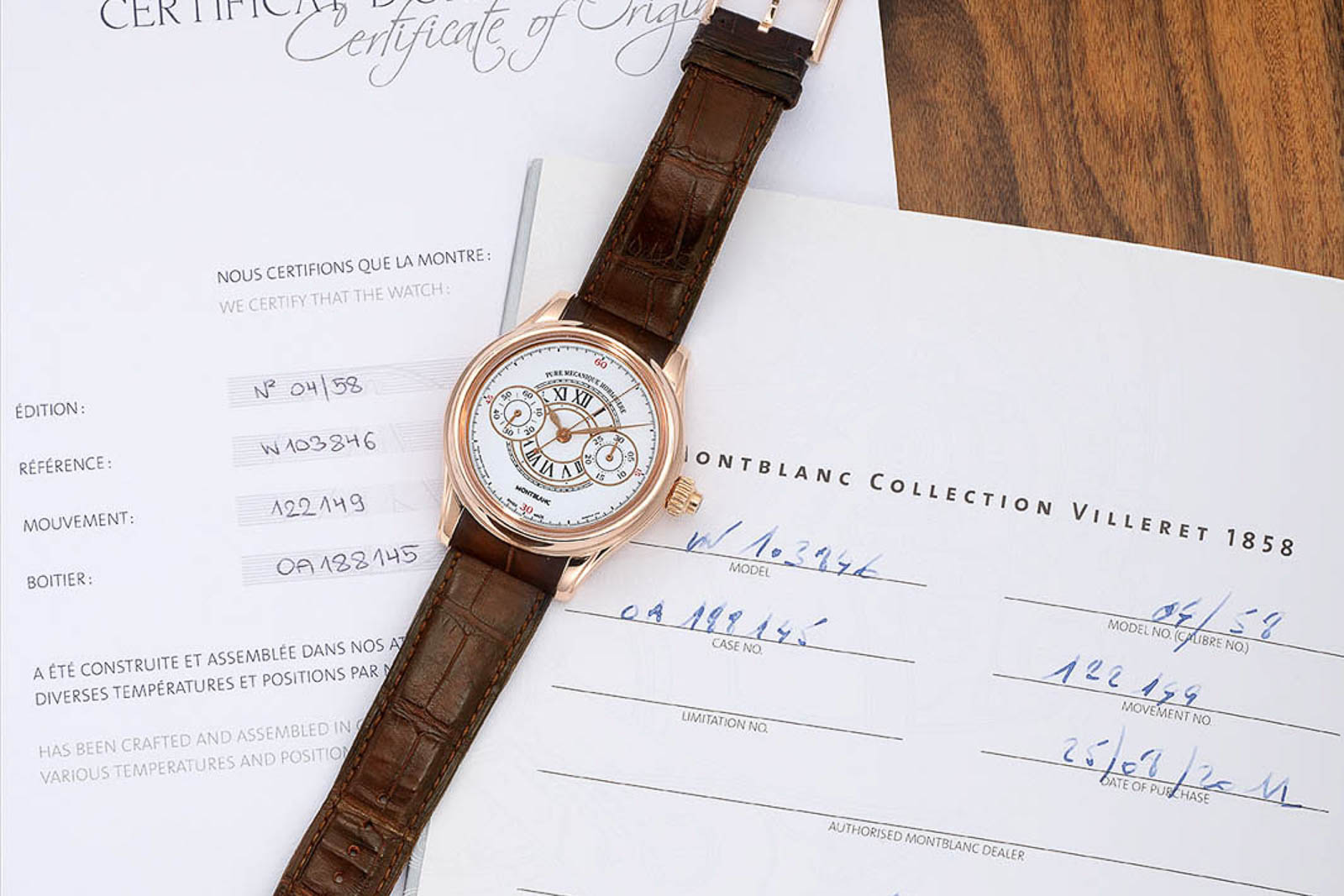
This is presented with its original and enormous wood box, as well as its certificates. The estimate is just HK$65,000–130,000, or US$8,300–16,700 – and the original retail price was almost ten times the low estimate.
1024 – Patek Philippe Nautilus Ref. 3800/1 in pink gold with ceramic dial
Not a complication in the same sense of the other watches here – the only complication is a date – this Nautilus ref. 3800/1 is an intriguing watch for several reasons. Though the Nautilus is now a (overly) famous watch accompanied by lots of hype, this is a very rare example of a less common model and one accompanied by an unusual letter.

Launched in 1979 as the alternative to the Nautilus “Jumbo” ref. 3700, the ref. 3800 was smaller at under 38 mm, in keeping with the tastes of the time. Originally a men’s watch but now decidedly mid-sized, the ref. 3800 stayed in production for almost two decades, resulting in a wide variety of styles and models.
Compared to the versions set with coloured gemstones, this ref. 3800/1 is subtle, but it’s amongst the rarest variants with just 10 known – a fact confirmed by a letter from the Patek Philippe Salon in Geneva that accompanies the watch.
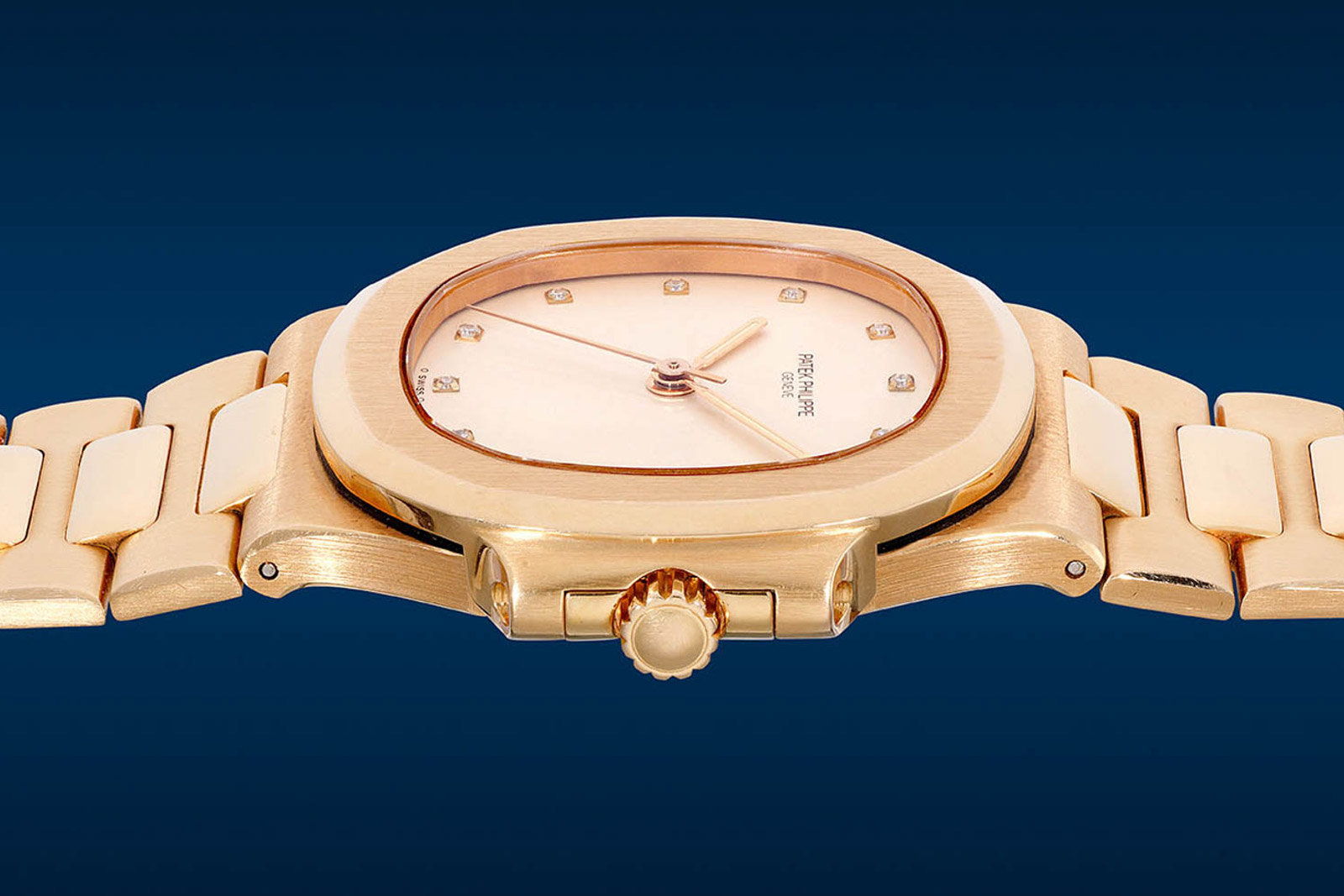
Dated 1990, the letter was written by the then-manager, Andre Glad, to the German owner of the watch and notes that only 10 of these watches were made, all of which were sold by the salon. The letter is both informative and rare; today Patek Philippe will not officially confirm production numbers in writing.

Also notable is the white ceramic dial – literally described as “blanc ceramique” on the certificate – that is slightly off white in shade and set with diamond hour markers. Other known examples of the pink gold ref. 3800/1 have the more conventional black ribbed dial.
The watch includes its original certificate, 1990 salon letter, boxes, and an archive extract. The estimate is HK$2.00-4.00 million, or USD$256,000–513,000.
1074 – Girard-Perregaux Opera Two
Part of the Opera trio of ultra-complicated striking watches, the Girard-Perregaux Opera Two was introduced in 2001 as the follow up to the Opera One, which was a tourbillon with minute repeater carillon striking the Westminster chime on four gongs.
The Opera Two added a perpetual calendar to the mix, making it one of the most complicated watches made by GP at the time. This example is in platinum, which combined with the tall case, gives the watch a surprising heft.

According to GP at the time, each Opera Two required about 500 hours to complete. Like the other Opera models, the Opera Two was powered by a movement developed in collaboration with Christophe Claret, then the leading complications supplier in Switzerland.
The hand-wind movement has a minute repeater carillon with four hammers and four gongs, instead of the two each in a conventional repeater. With its quartet of hammers and gongs, the Opera Two can chime the same tune as Big Ben in London’s Houses of Parliament. Most of the intricate strikework is visible through the back, while the hammers and gongs are visible through apertures on the dial between eight and 10 o’clock.
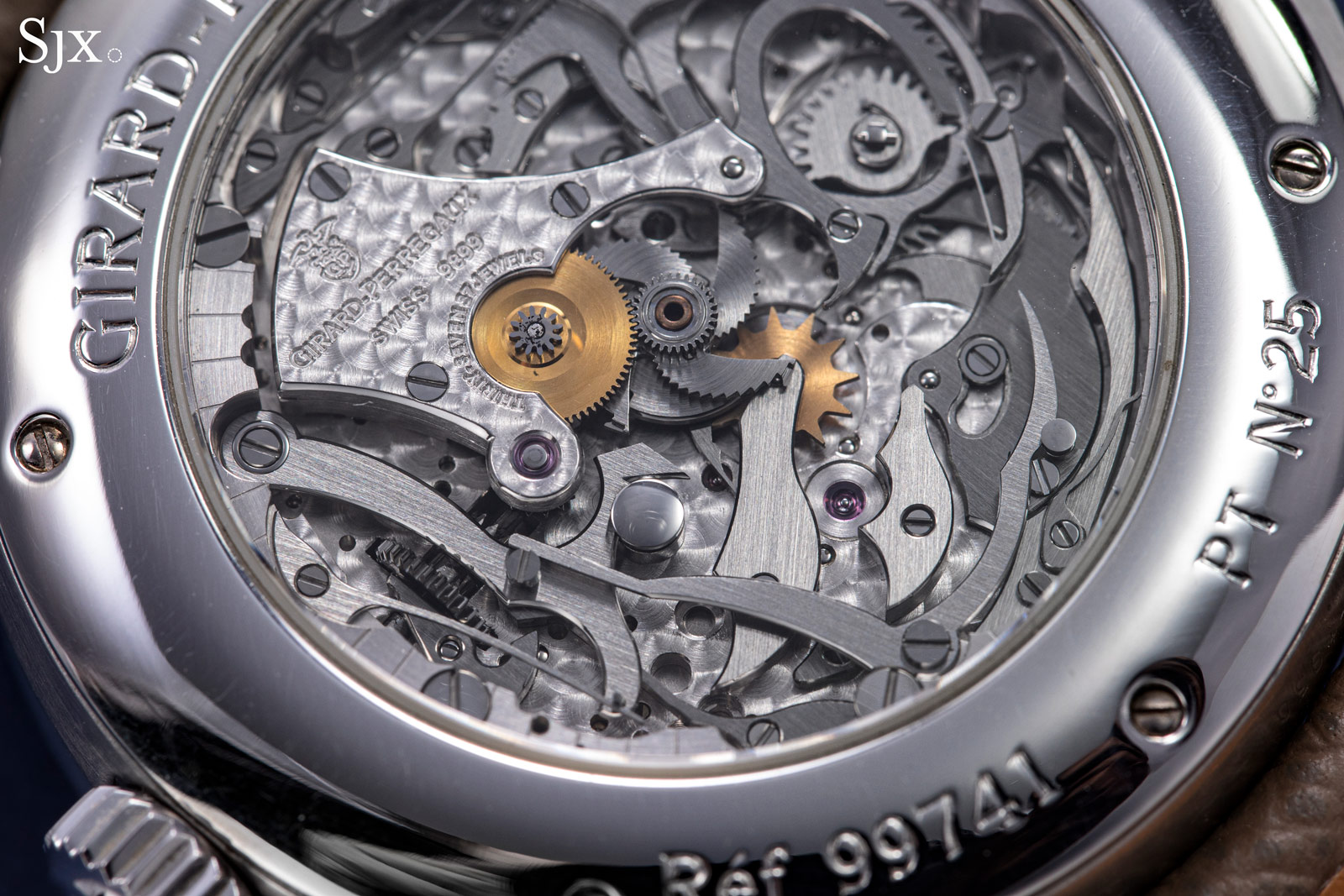
The rest of the dial is occupied by the perpetual calendar indications, along with the tourbillon that’s visible at six.
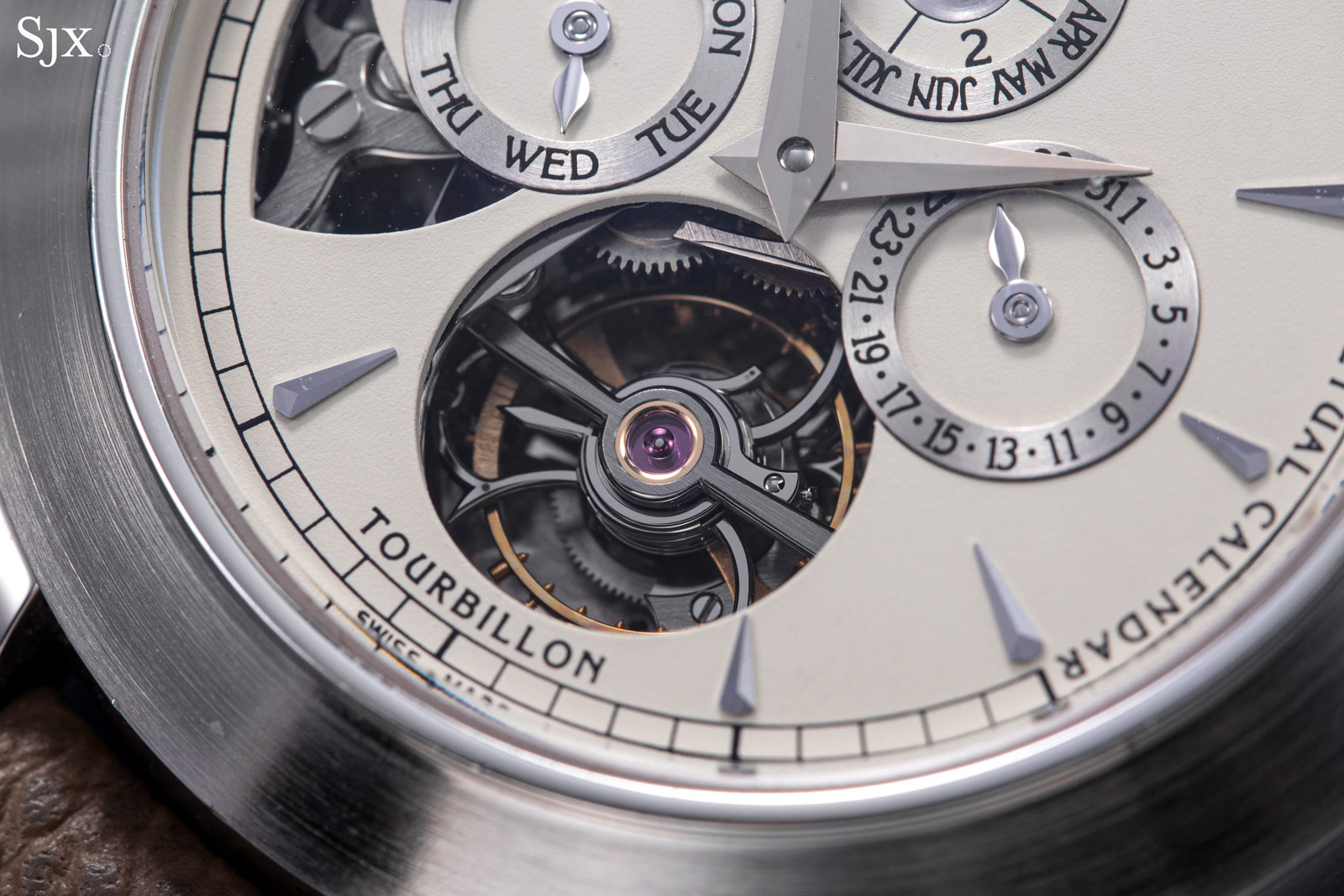
The Opera Two is accompanied by its certificate signed by GP’s then-president Gino Macaluso as well as other papers. The estimate isHK$1.00-2.00 million, or US$128,000-256,000.
Preview and auction
The sale and preview exhibition will take place at Phillips Hong Kong in the West Kowloon Cultural District.
G/F WKCDA Tower
Cultural District
8 Austin Road West
Kowloon, Hong Kong
Preview
Open daily May 17-25 from 11:00 am-7:00 pm
Auction
May 24, 2:00 pm (lots 801-934)
May 25, 2:00 pm (lots 935-1083)
(All times are local to Hong Kong, GMT+8.)
The catalogue and online bidding are available on Phillips.com.
This was brought to you in collaboration with Phillips.
Back to top.
